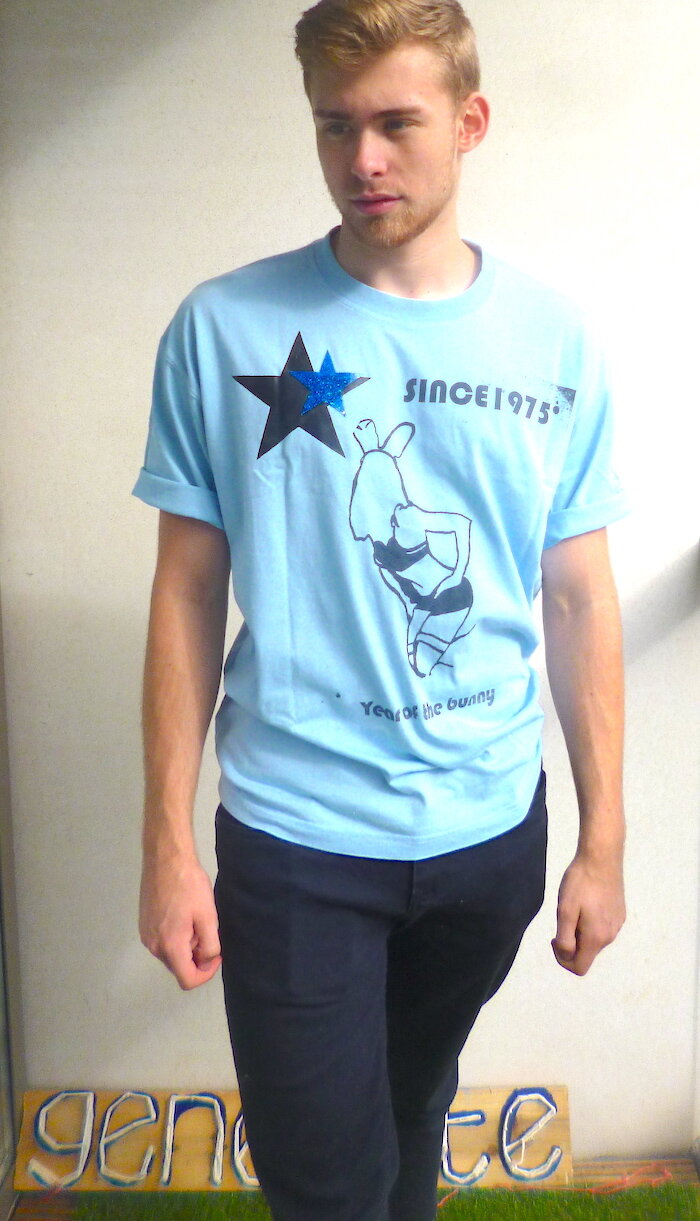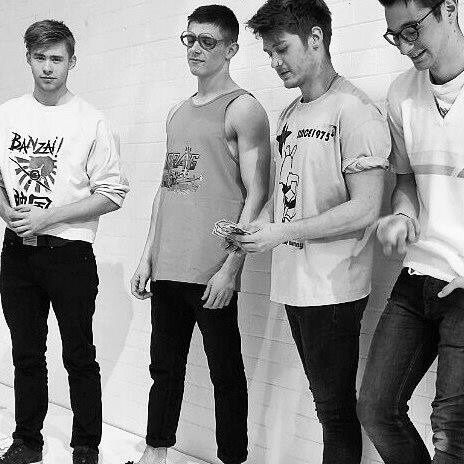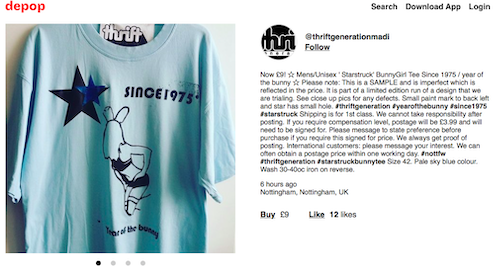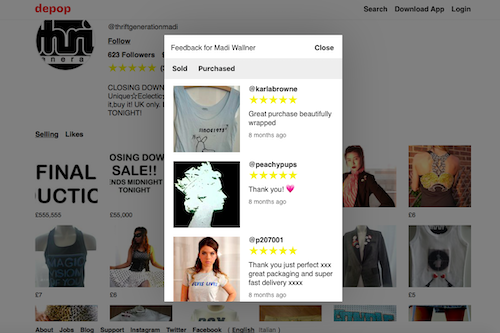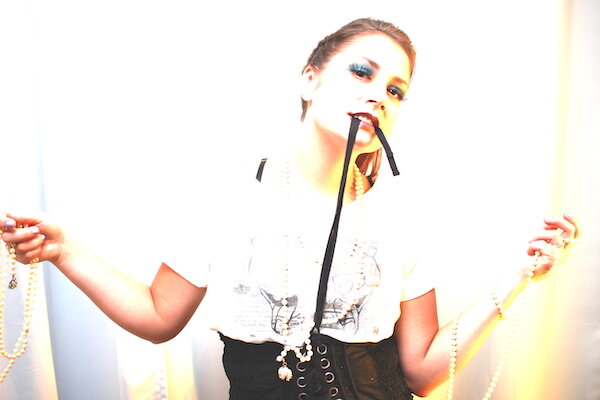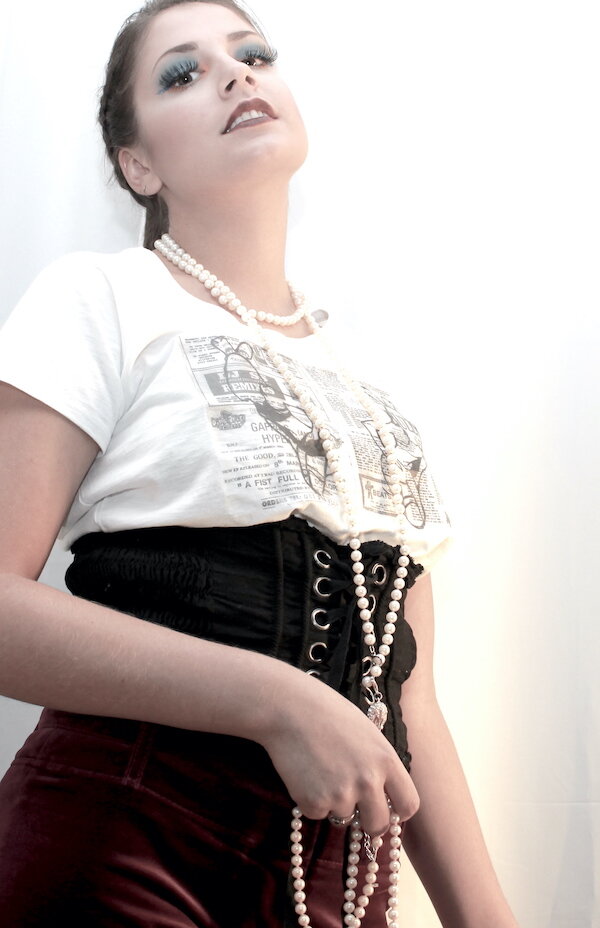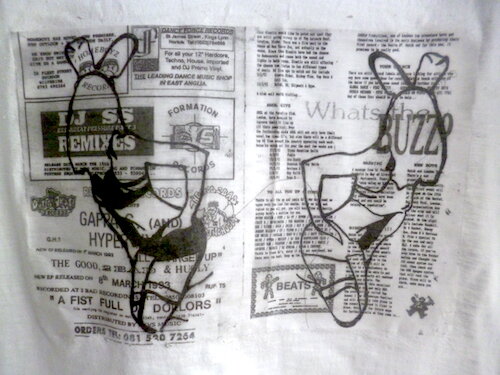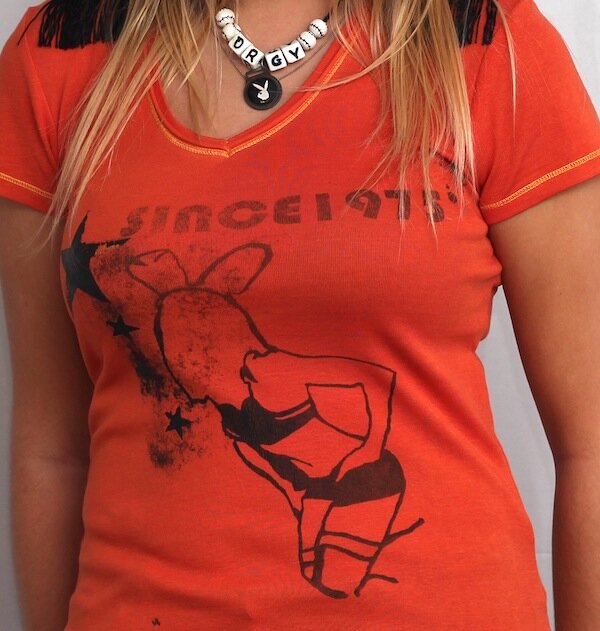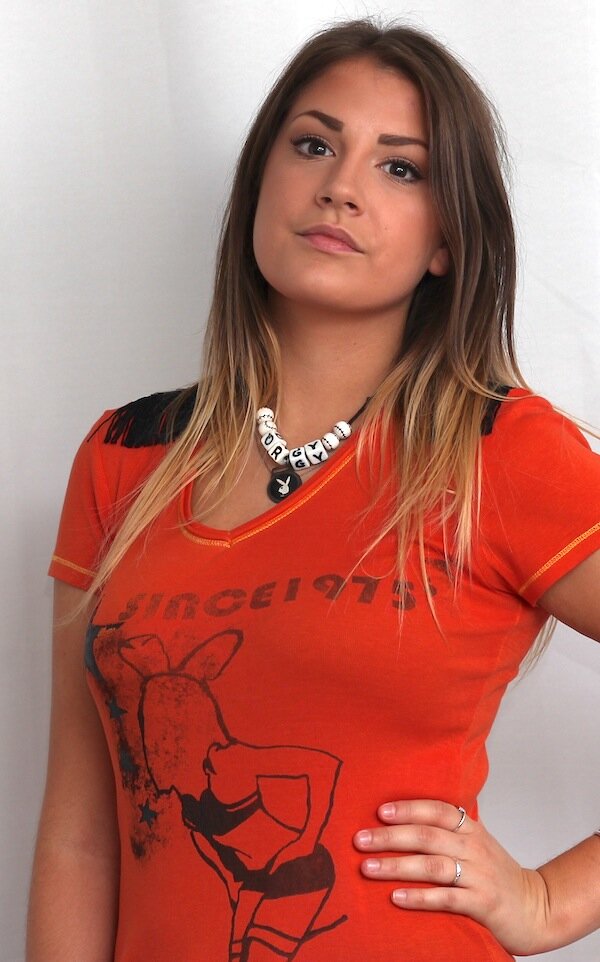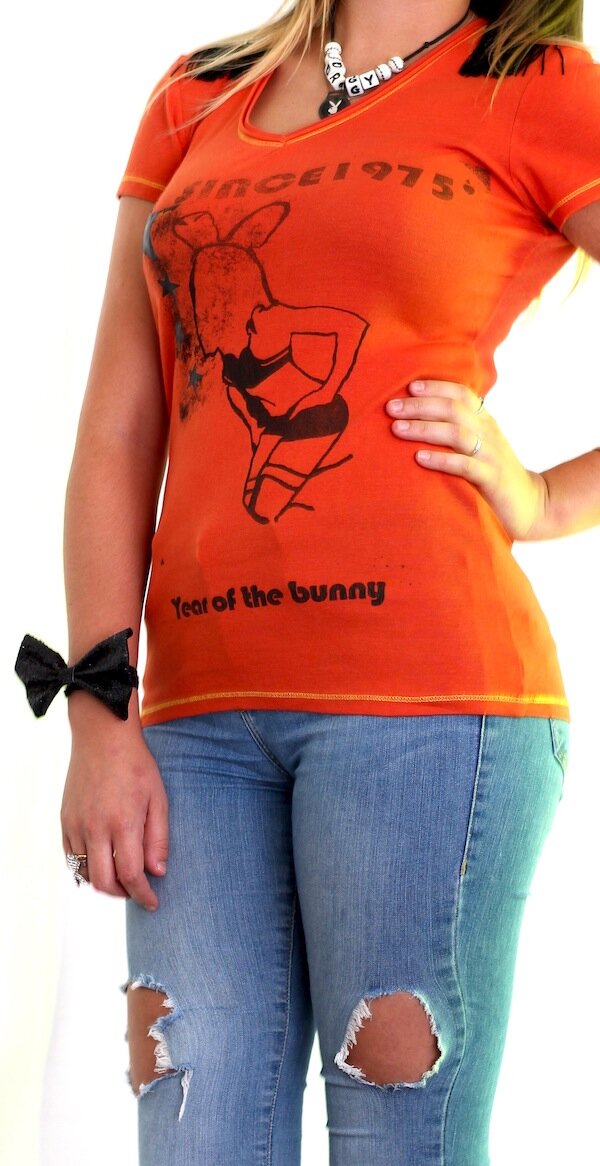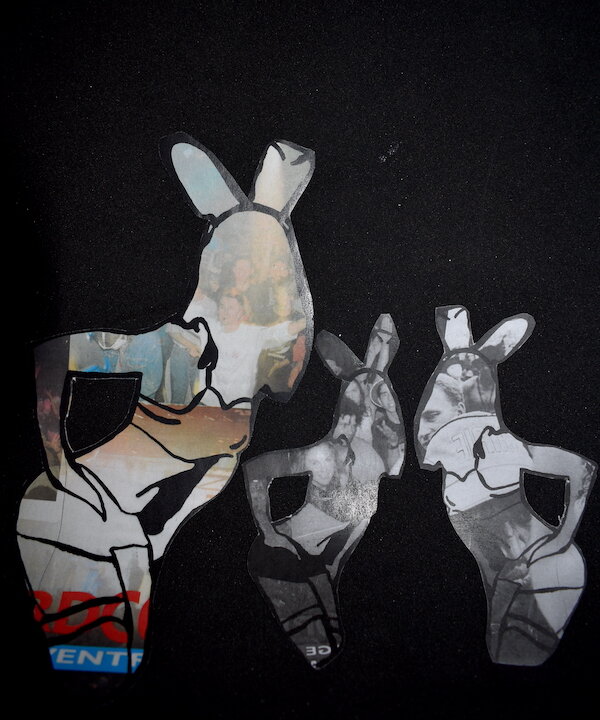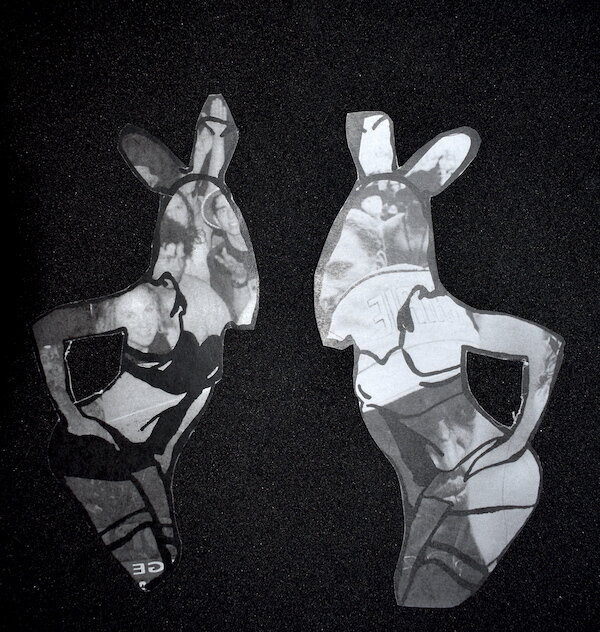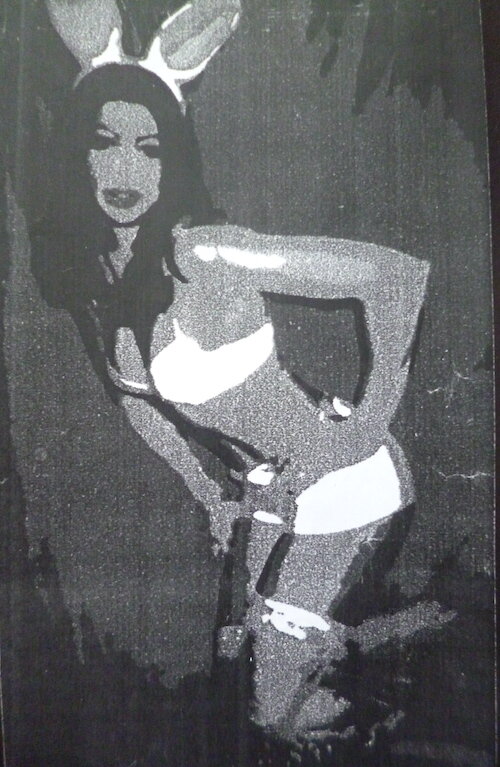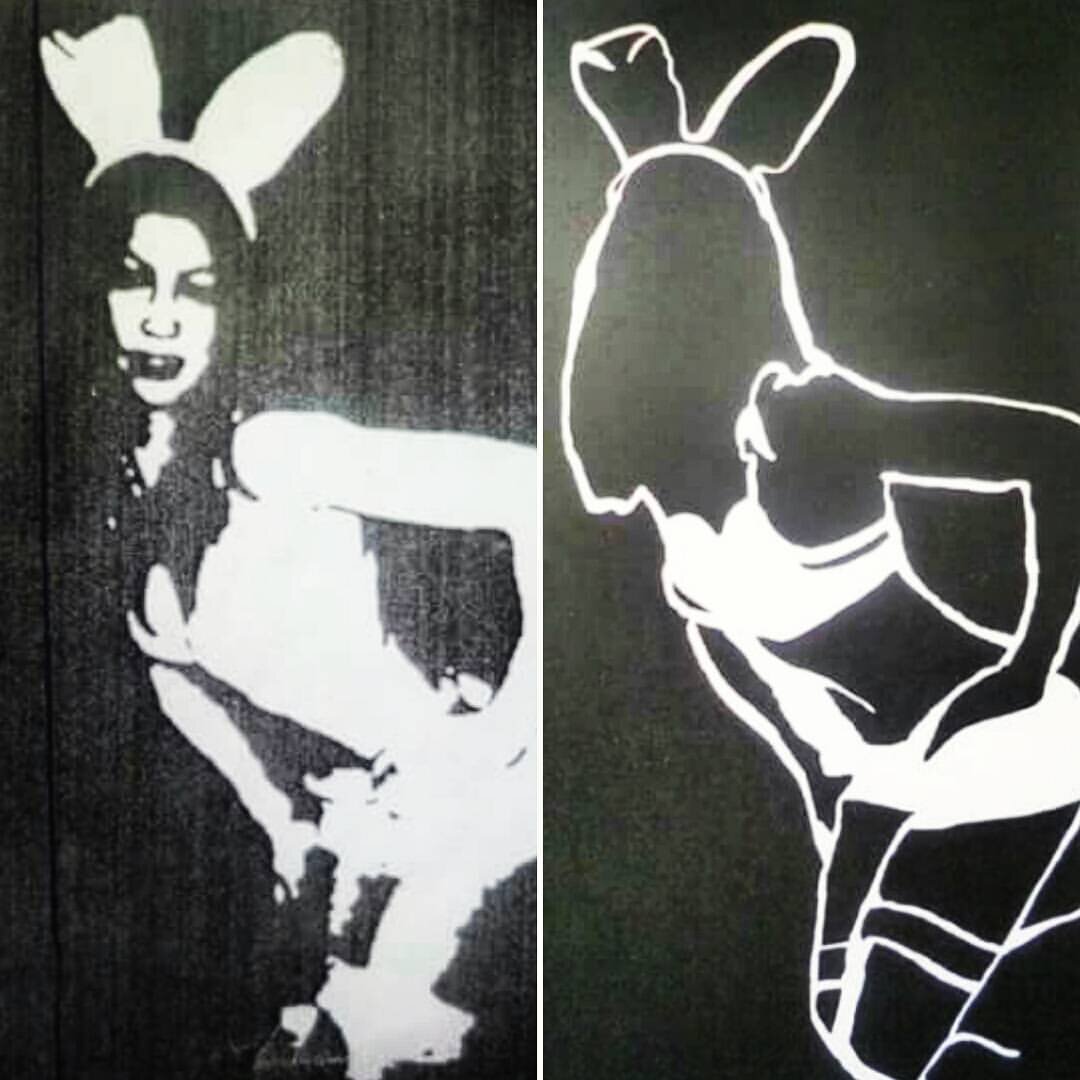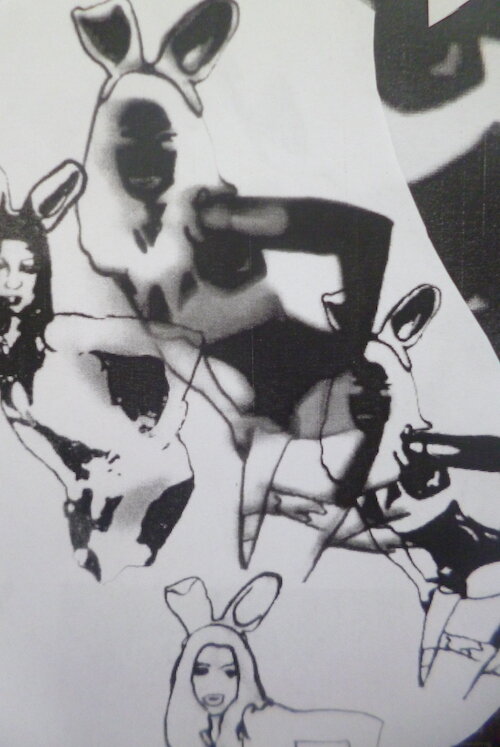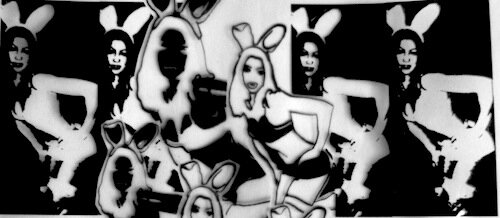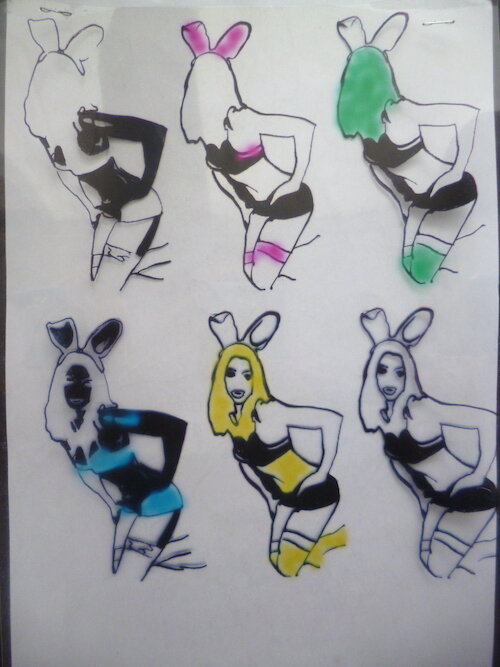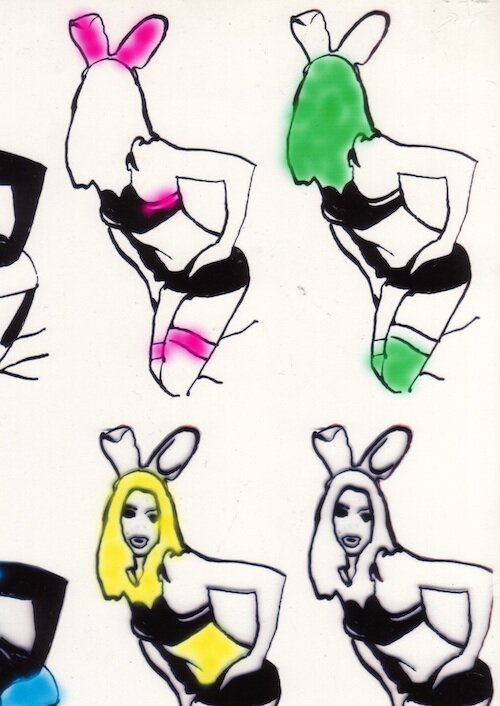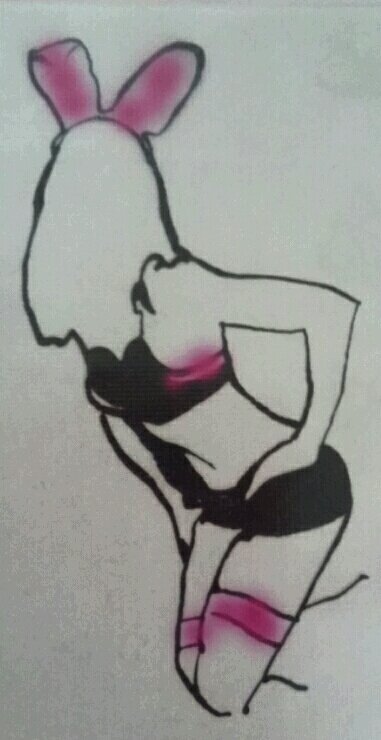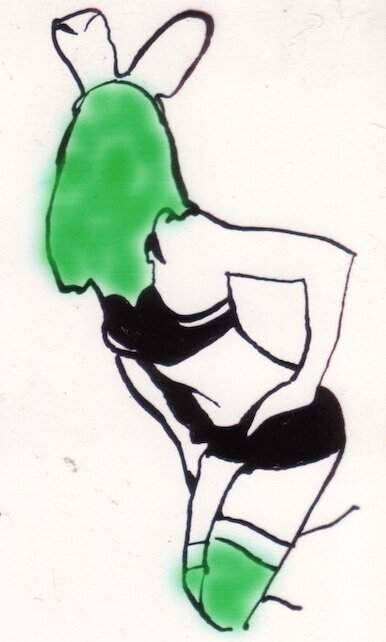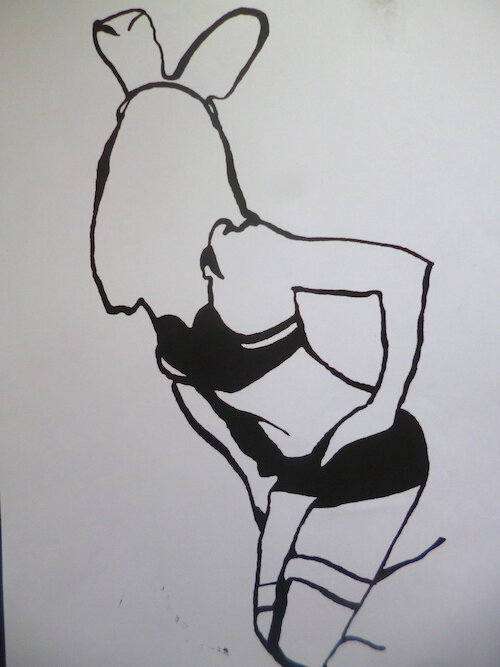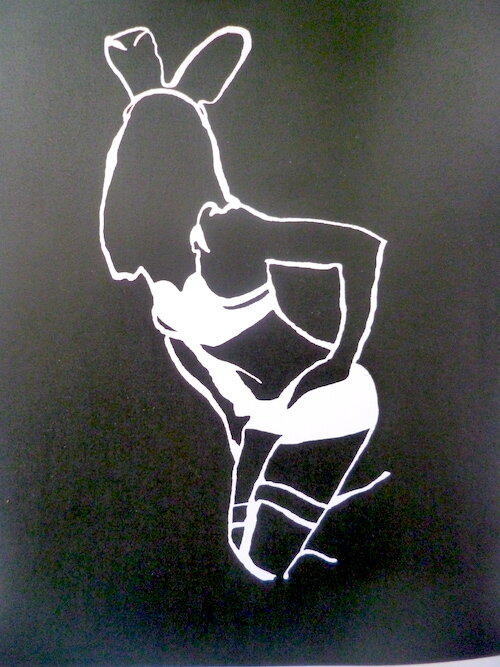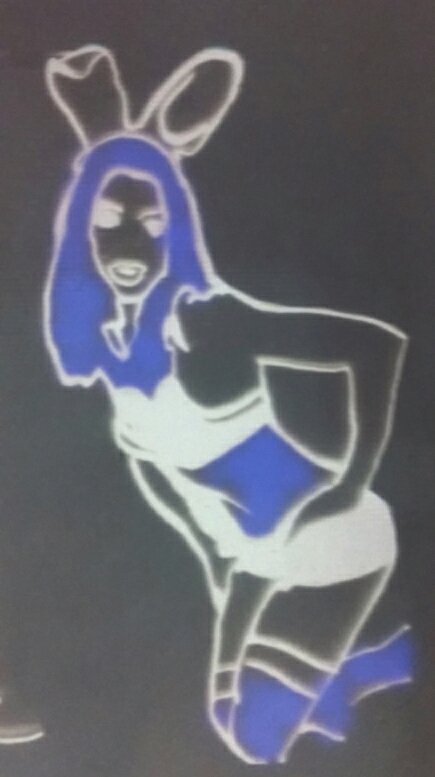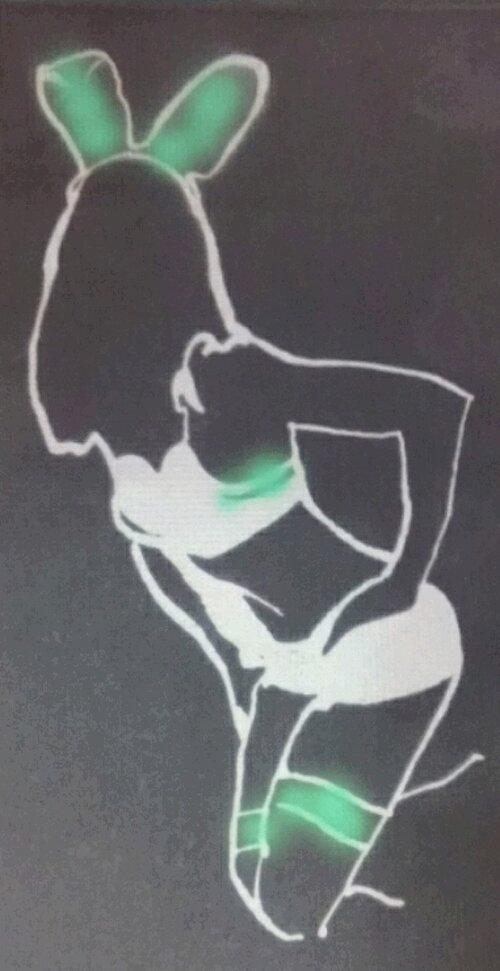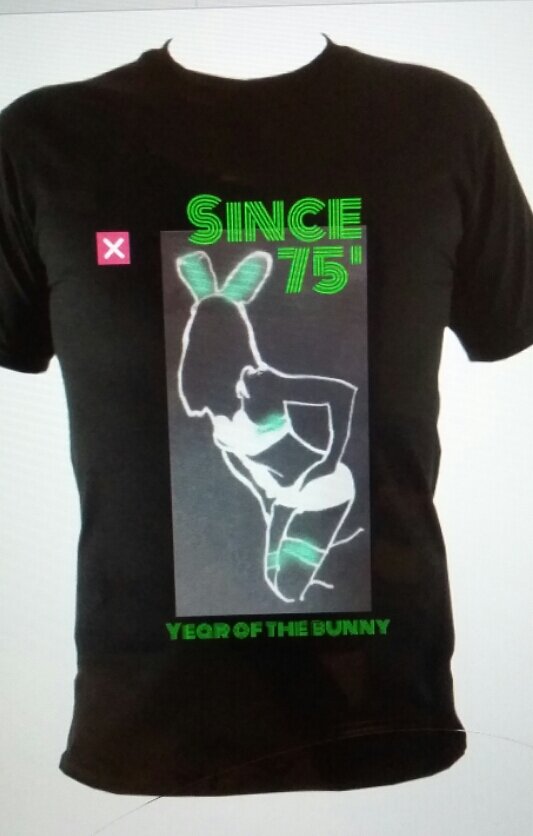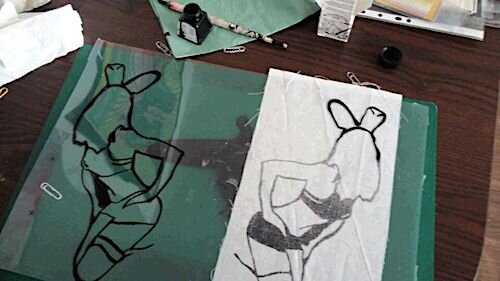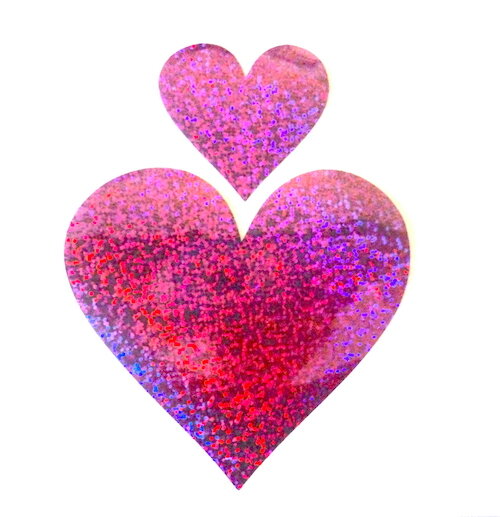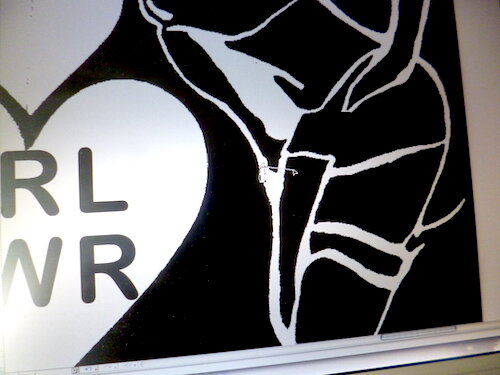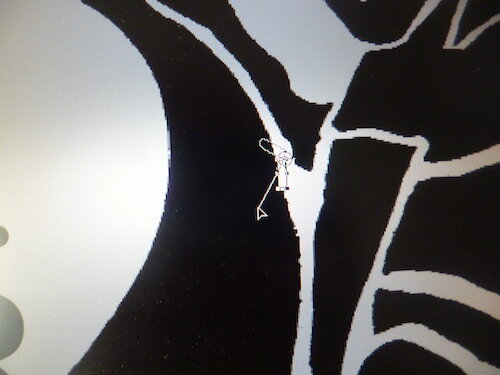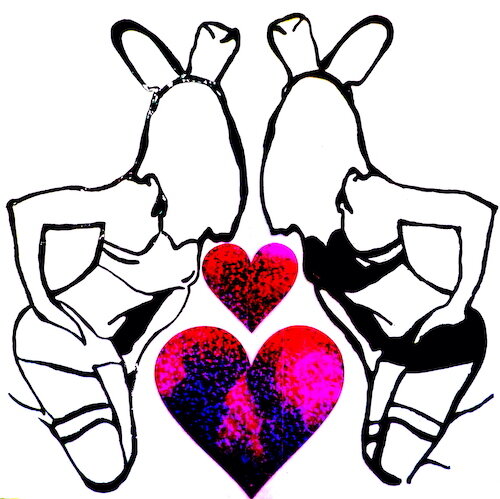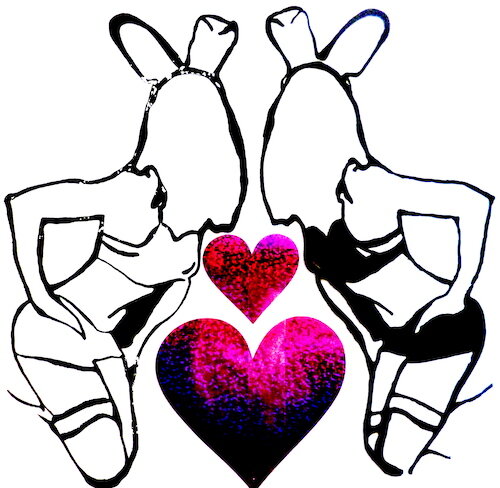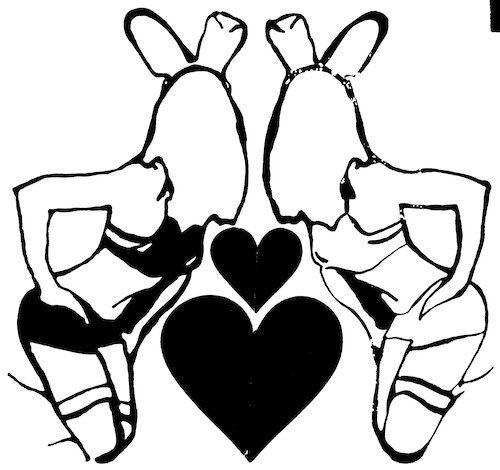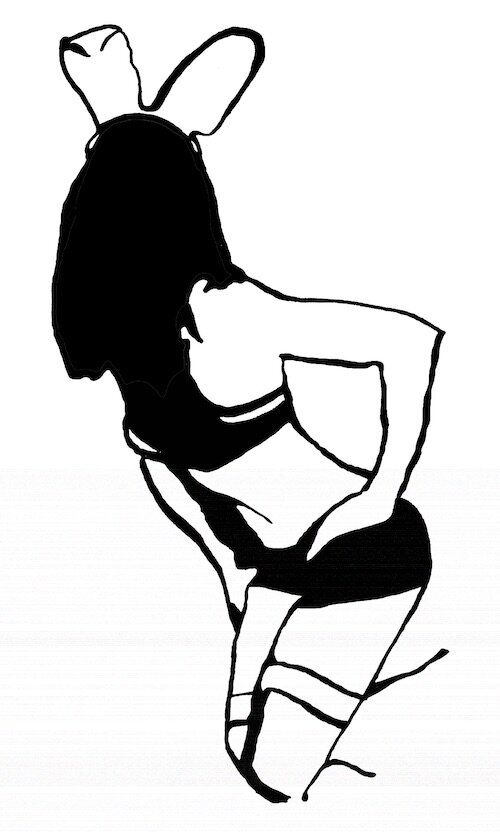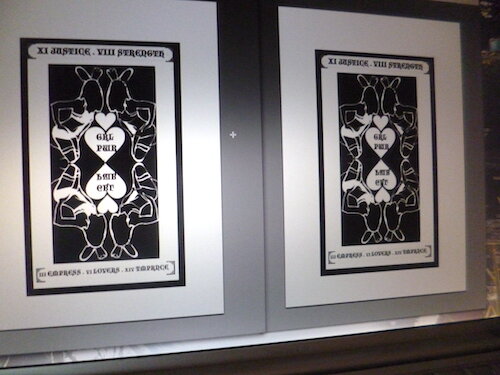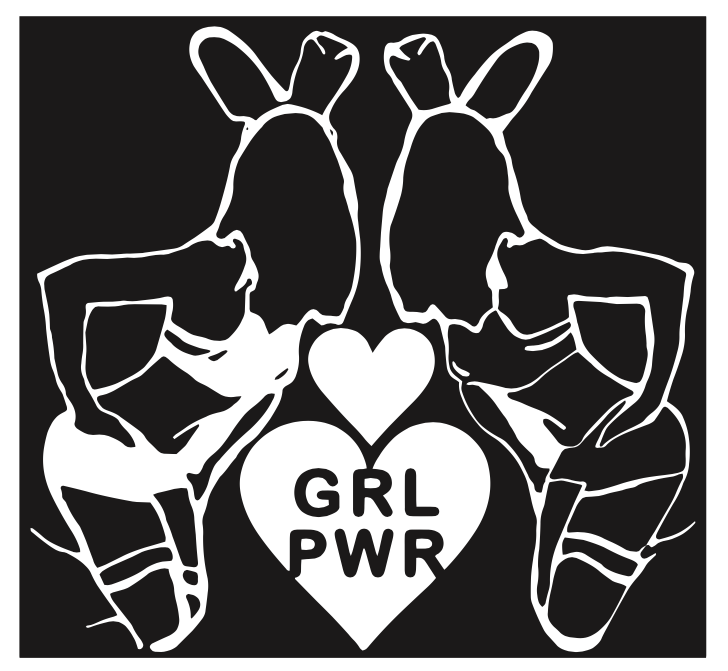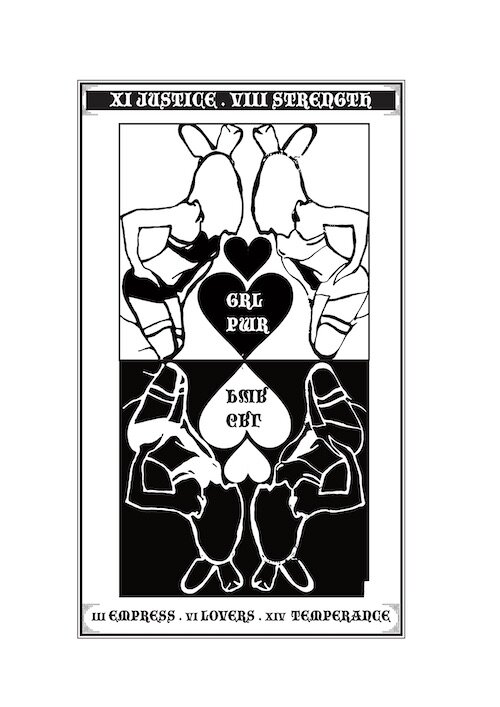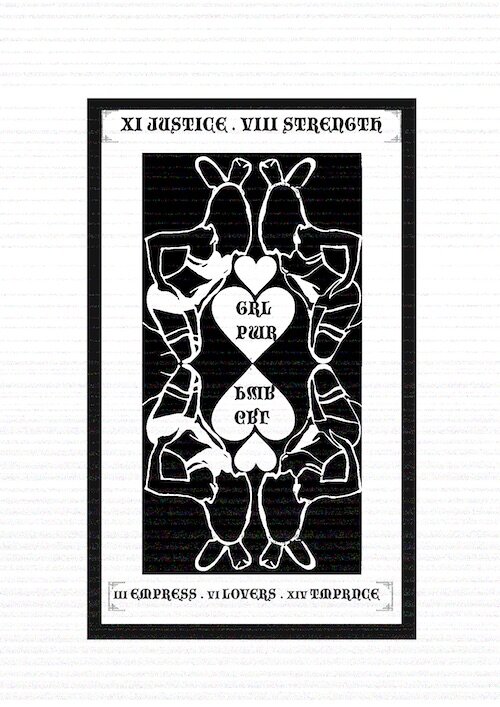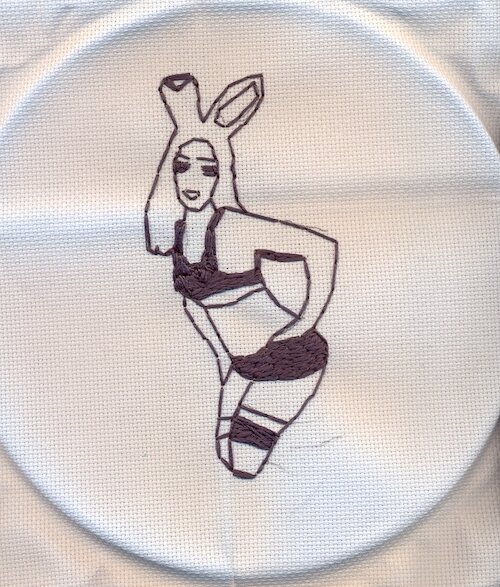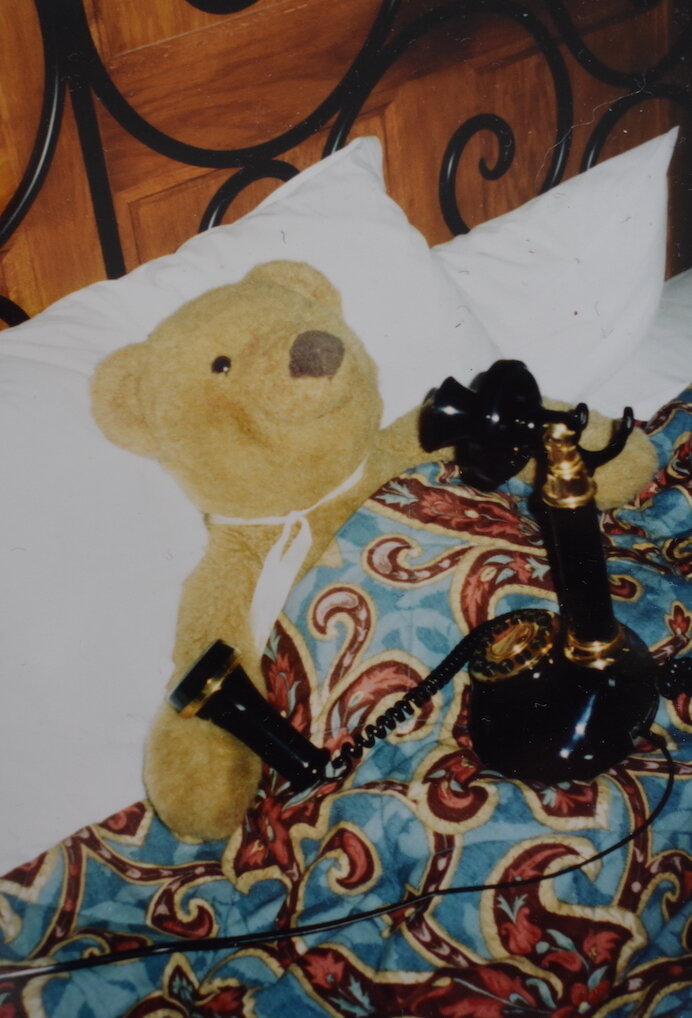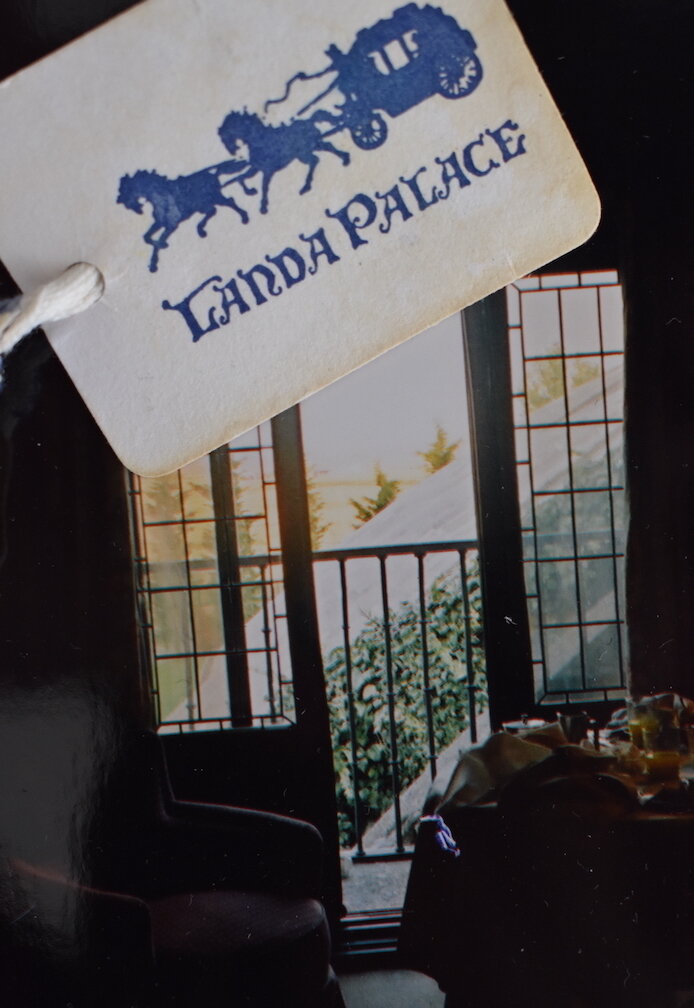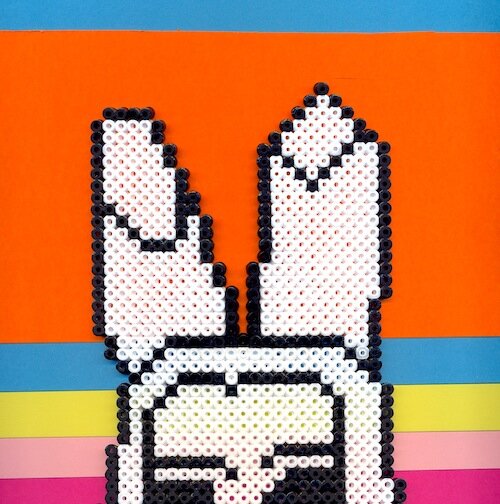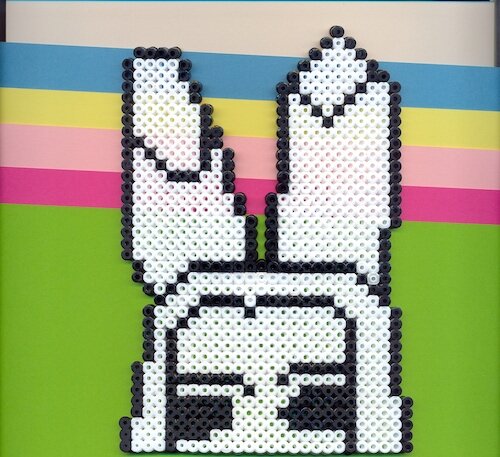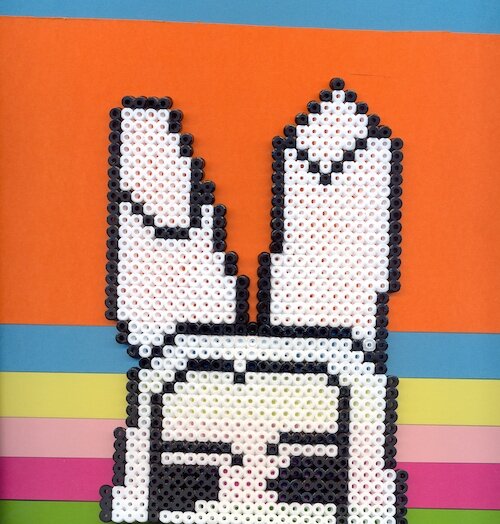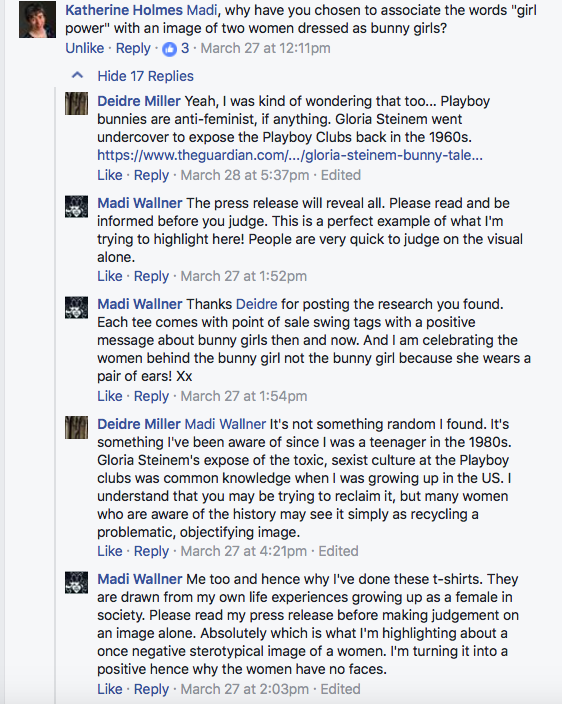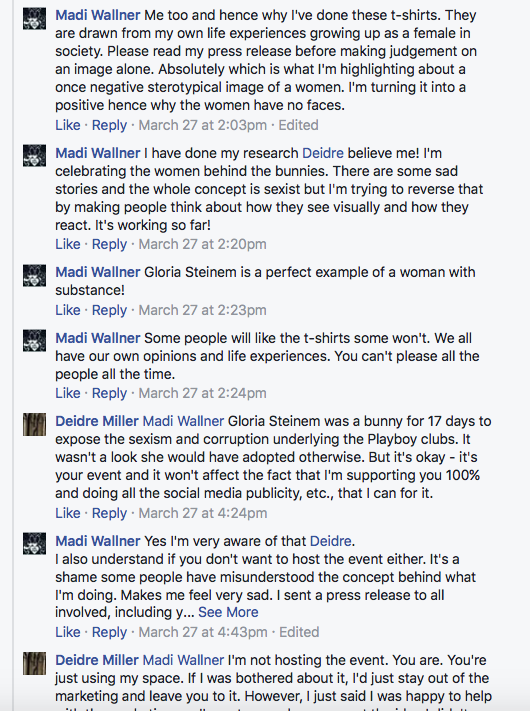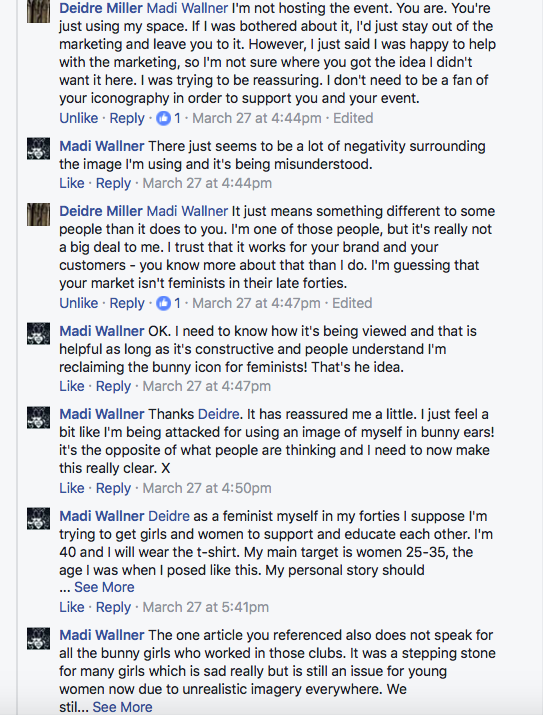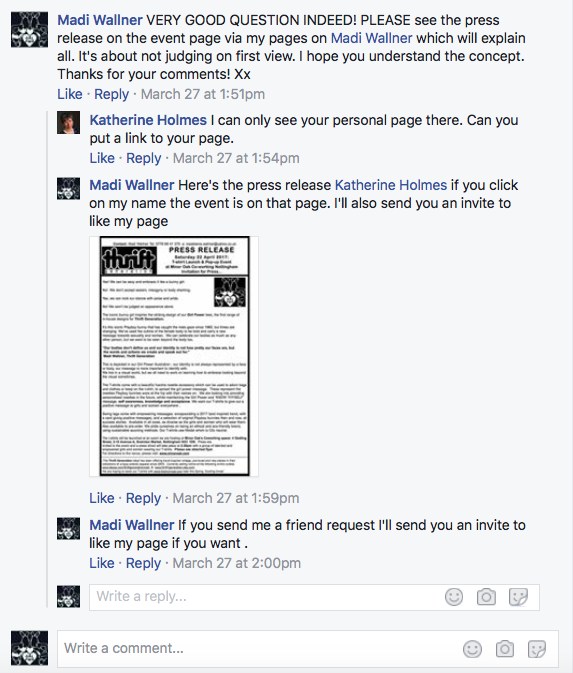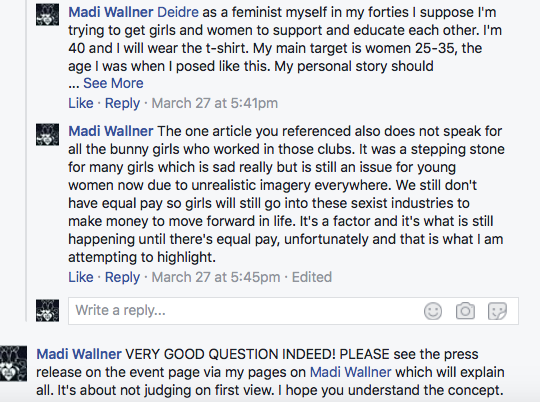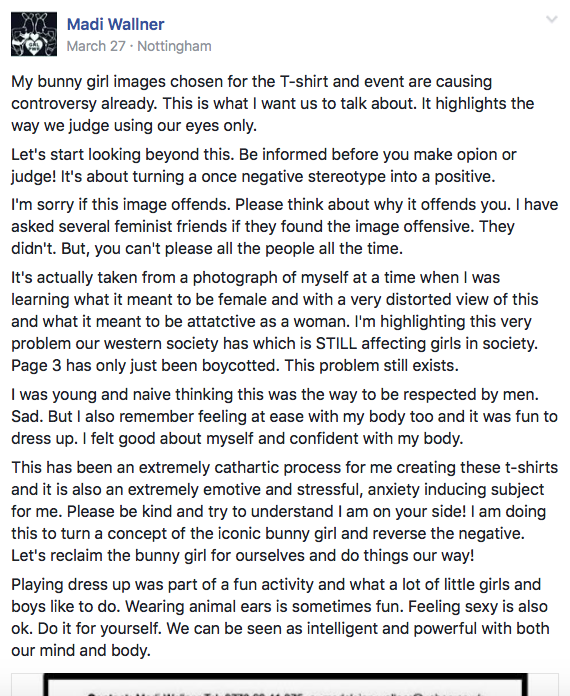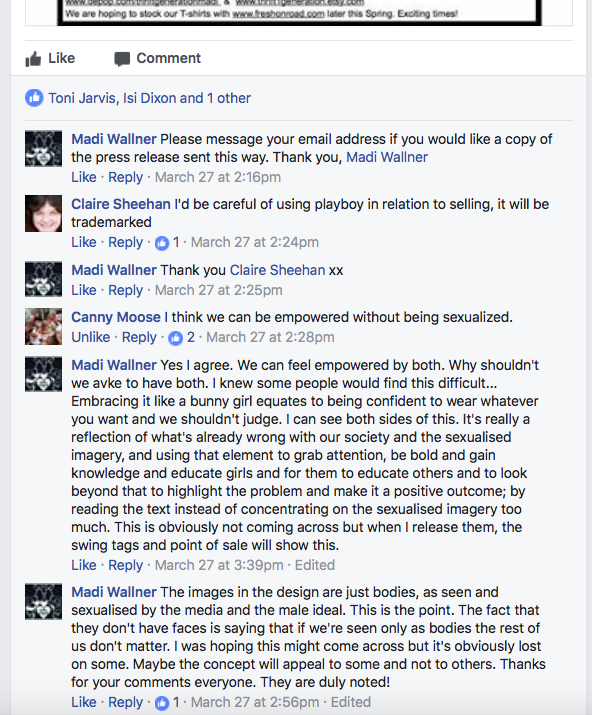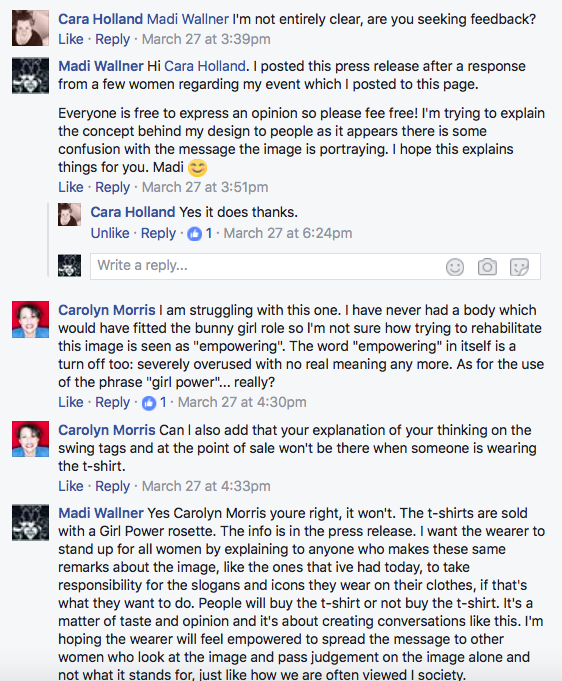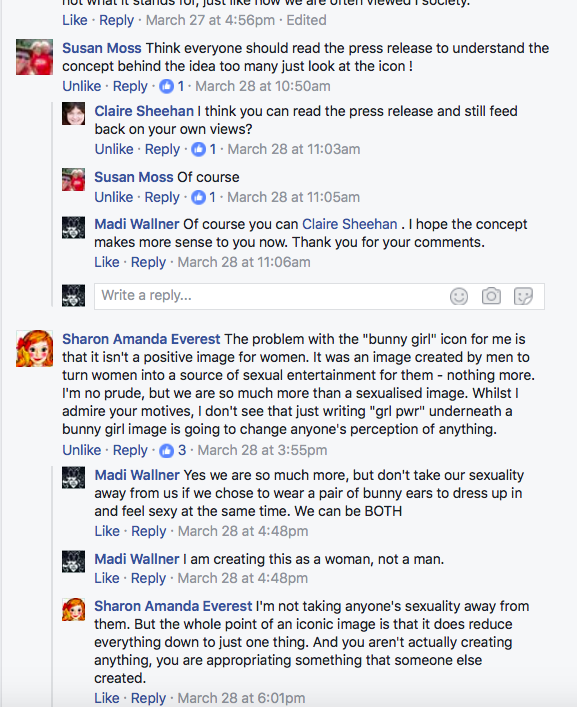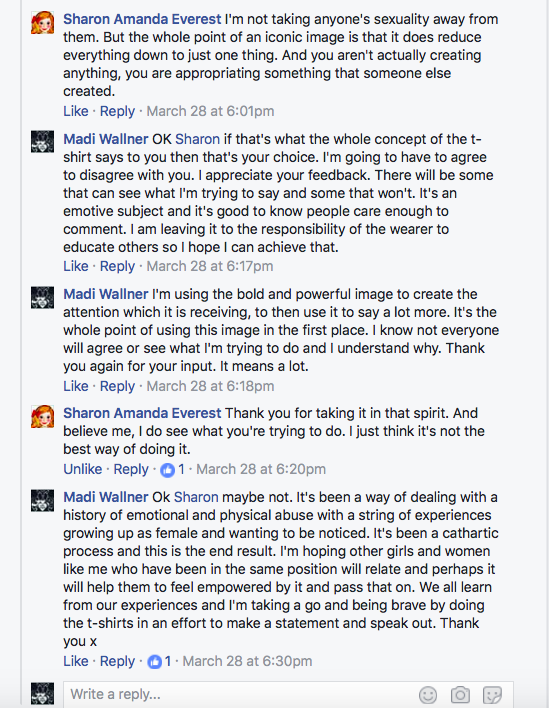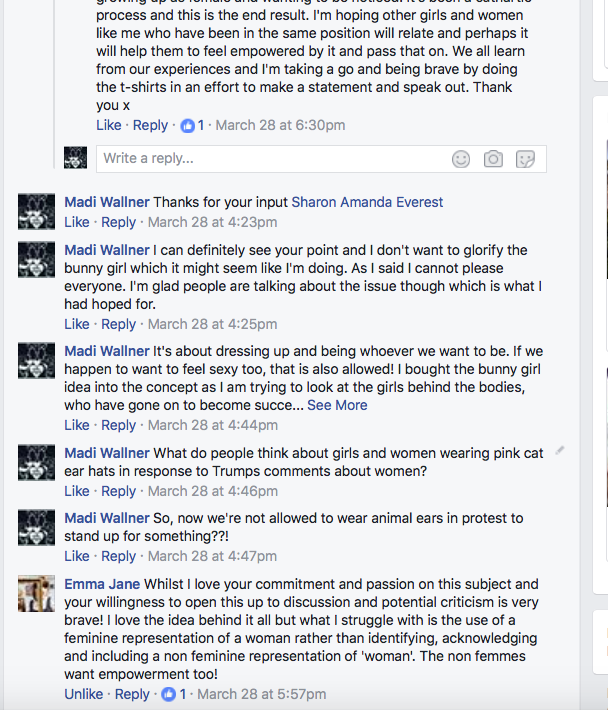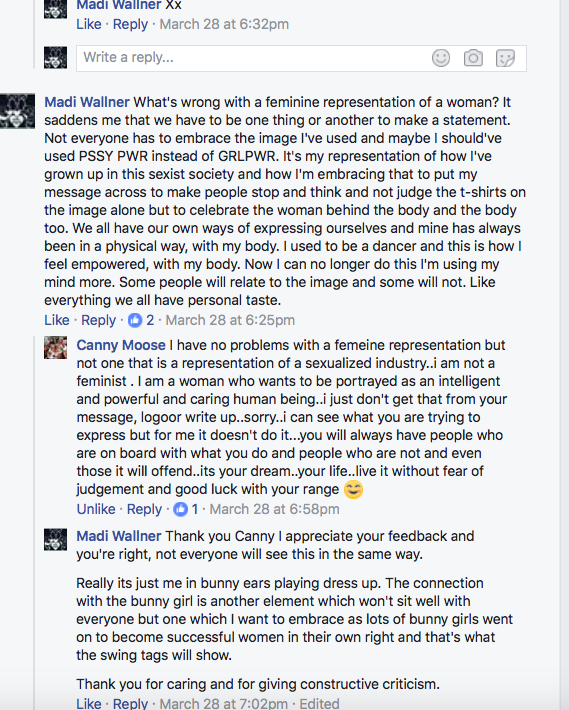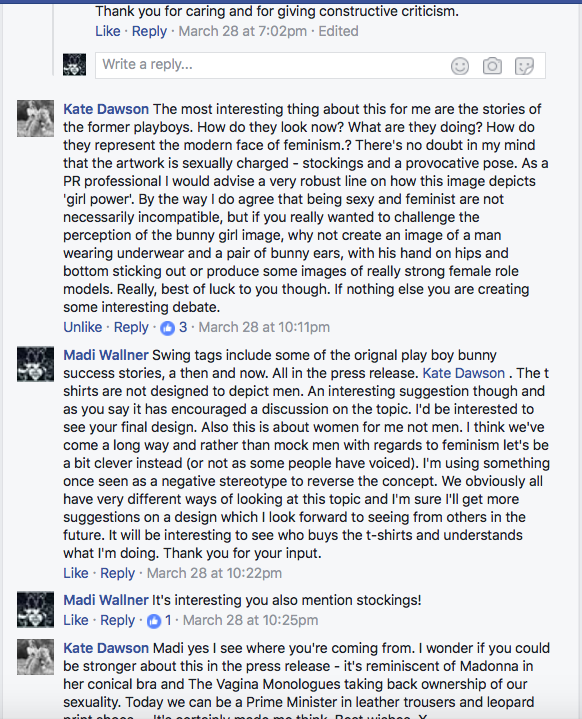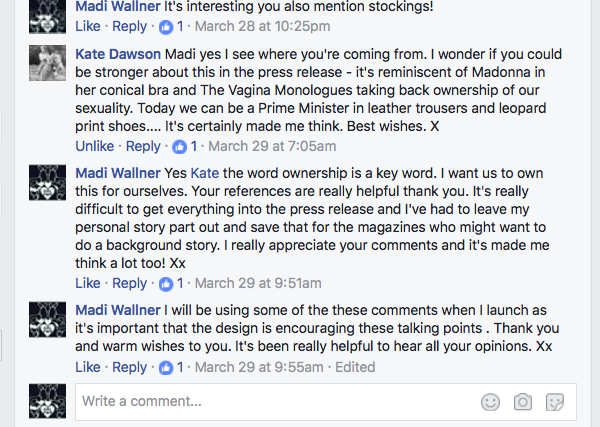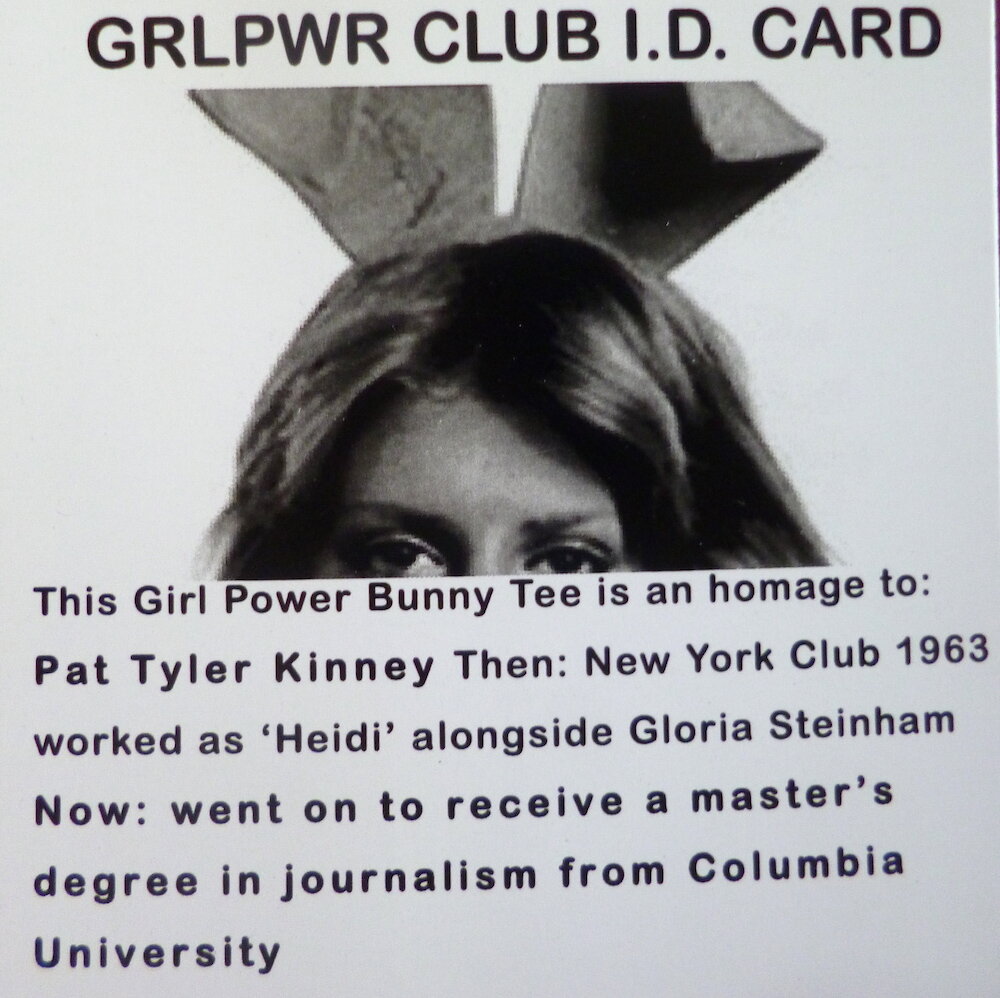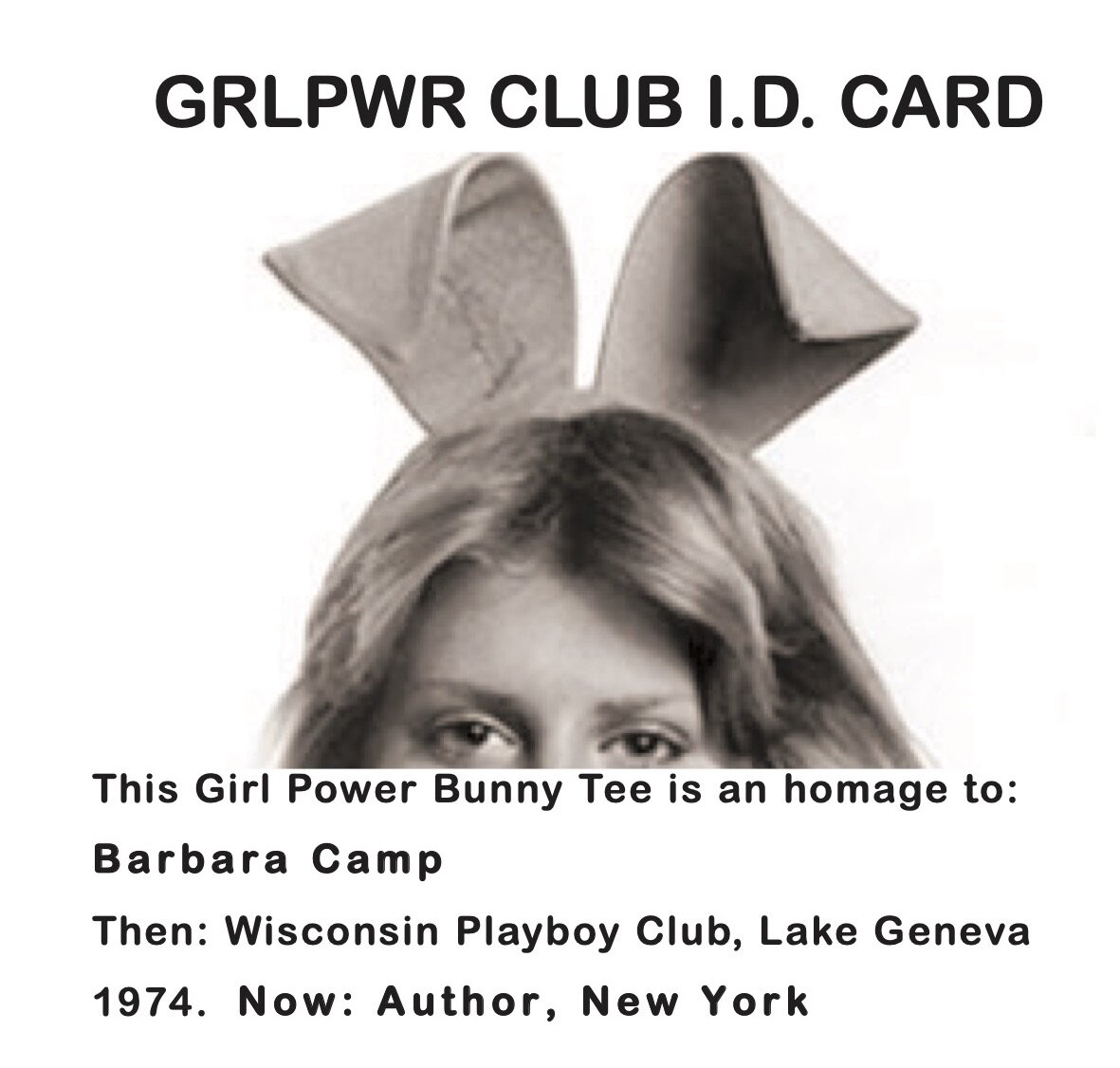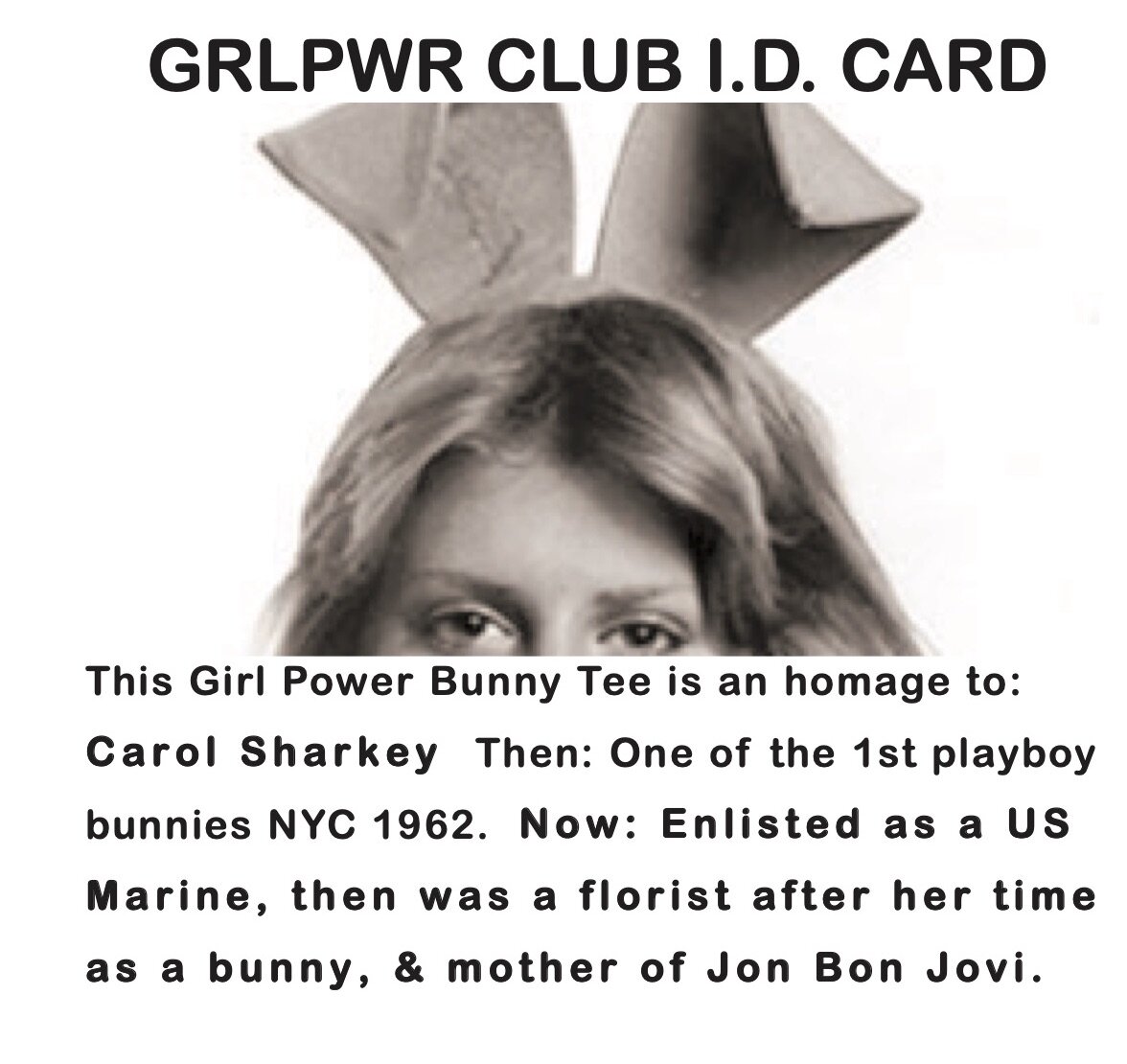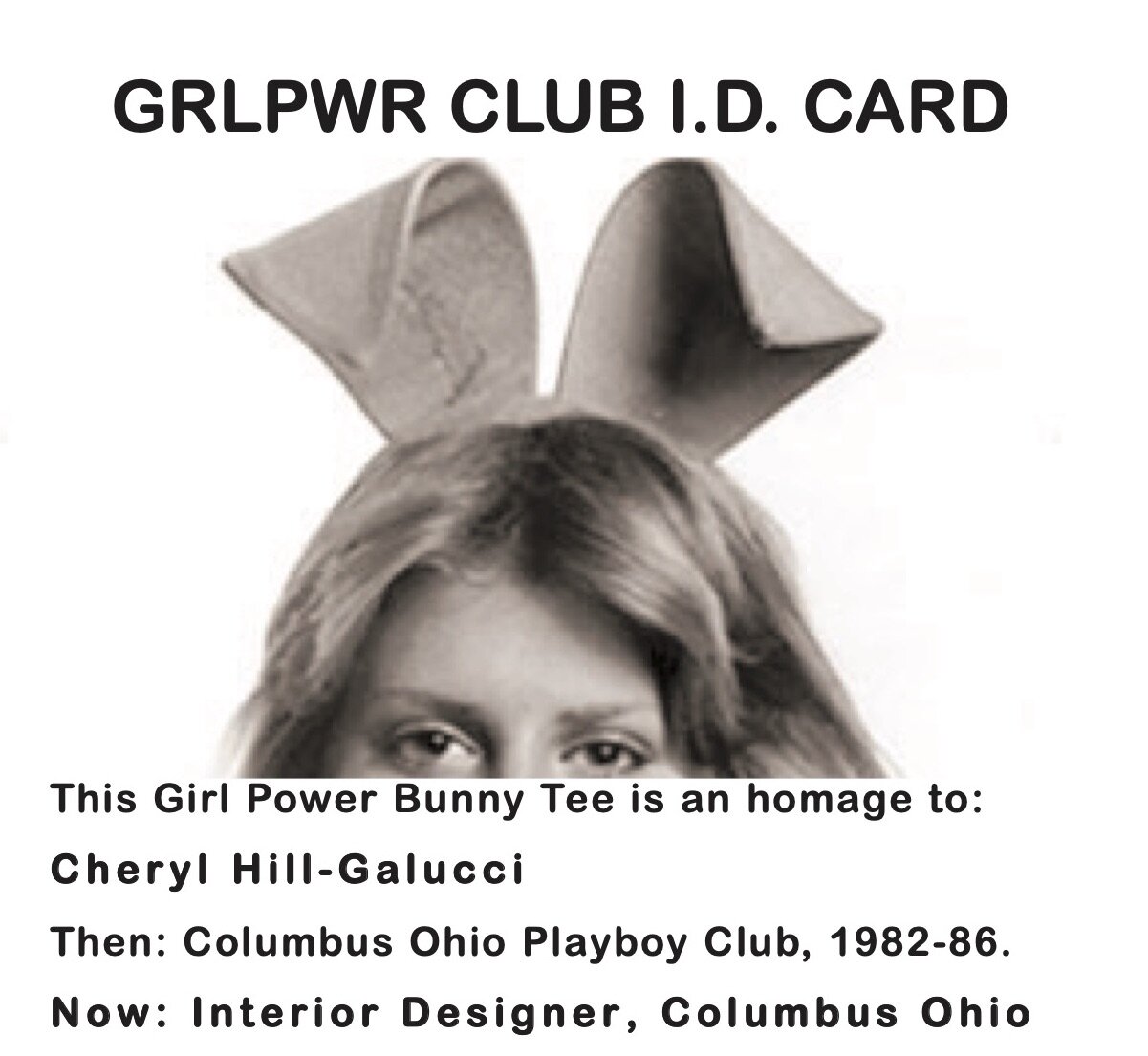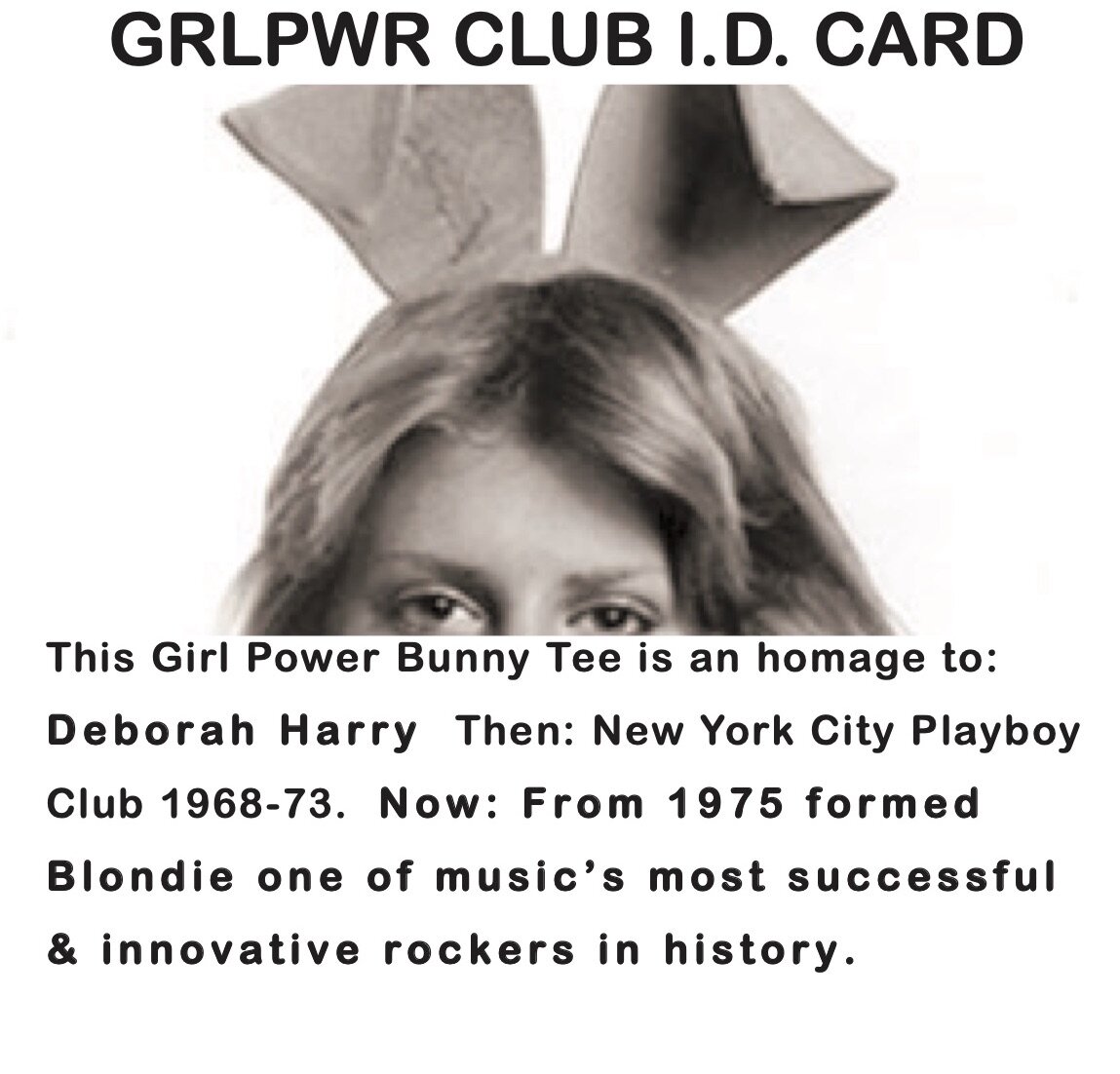Beyond The Bunny - Reclaiming An Icon For Feminism
The Story Behind the Bunny T-Shirts
(Trigger Warning)
The T-shirts I designed were created alongside therapy during rape counselling, creating something out of it that was positive and a cathartic (and at times painful) journey. It was my first step on the ladder of therapy to deal with a series of traumas in my life, several of which were related to sexual and emotional abuse, mainly during my 20’s and 30’s. I made it to represent myself in a positive way after overcoming sexual violence and also because I was born in the year of the bunny. I am a wooden rabbit.
I showcased the first early bunny design at Nottingham Fashion Week, opening the Independents catwalk show in 2016. This was set to kick start the label again, evolving Thrift Generation into what it is now. I sold one of these T-shirt designs on Depop to a young girl who liked my ‘Ghost Bunny’ design. I was enjoying experimenting with the design that I’d created.
The design then was just one bunny and some text, as a silk screen experiment during an evening course I was doing at Central Nottingham, at their Clifton College campus. It was an attempt to turn a negative experience into a positive one as I tried to find creative ways to stay focused while dealing with an ongoing chronic health condition. I tried out the bunny design as an homage to myself really, to turn something that came out of a damaging relationship into something good.
I added ‘1975’ and the ‘Year of the Bunny’ as this is my Chinese year of birth. The year also sits in line at a time of unrest, with regards to The Playboy bunny girls, and sexism; with the Women's Liberation movement landing on the doorstep of Hugh Hefner’s clubs. More about this on page 206 and bunny stories here
Eve Stratford, a Playboy bunny at the time was also raped and murdered that year.
Utilising my design to see what interest there was with my ‘Dirty Bunny’ and ‘Rave Bunnies’ as imperfect samples. I tried the Rave Bunnies using a high street alternative (a long and messy process), just to see what the design would look like (the effect is like a hardened version of paper on fabric - I still wear this one sometimes though as I like the design.
Above & Below: Experimenting with the Rave Bunny concept using old rave flyers
The whole process of the original design to use as a simple screen print took ages as I didn’t have access to the computer software. Photoshop and Illustrator had moved on since 2003 when I was last using it at university.
It wasn’t part of the screen printing course I was doing at the time, but we had to prepare it using this software to get the screen print-ready. It was a bit frustrating and a case of muddling through and asking constantly for help. Before I even got to this point, I had to use Indian ink and acetate, which helped me to realise my final design, prior to getting it digitised for the first screen print test. As usual, it was a case of finding creative solutions.
The photos below show some of the process, but for a full account with descriptions, please see my Facebook album: The Bunny Girl Tee Journey (this might just take you to my personal Facebook page which is where this album lives as it was before I set up the ThriftVIP business page. Look at my photos from the album if you want to see it).
The decider to evolve the design though, was a comment from one of the older fellow course participants. He said that my design ‘wasn’t very feminist.’ I liked the fact that a middle aged man had pointed this out. It was International Womens’ Day too. So, I decided there and then that my purpose was to make the lone bunny design into something that would give a new feminist message, using the bunny design in the best possible way I could. In a way, it acted like a metaphor for turning things round for myself too, using an old image of myself to highlight something new about how we can change and evolve. It went from just being about celebrating myself, to celebrating all women. I love a challenge!
And so the design was formulated with the two bunnies, united
Above: Identity isn’t always black and white. The final design, assisted by a local graphic designer, who I paid to vectorise the image in readiness for a local screen print company who were going to print the T-shirts.
Below: Manipulated further to create swing tags following intensive tarot research, looking at symbolism through history. I quite like these as a design to realise for more T-shirts.
Culture
The year I was born, the culture I was brought into, and the experiences I’ve had as a female growing up in our society, have all had an obvious affect on how I’ve viewed and identified myself as a young woman over the years. I’ve only ever really felt as good as the body and face that I have. This has been mainly due to the advertising I’ve been exposed to, the opportunities I’ve had and what other men have said to me. This aspect has always felt to be the first and foremost, most important aspect of how I’m perceived and valued.
Things have only really started to change more dramatically recently, with the advent of the #MeToo movement. Some things have not changed enough yet, especially with regards to equal pay and workers rights; care workers being an example of this, highlighted during the COVID-19 pandemic. Then there’s sex workers and their rights too, not to mention the black African and Caribbean, Indian and Asian communities, which is all part of our responsibility as a society. It seems that, for many of us, our bodies have funded the path to our true vocation, because of the sexism and exploitation that exists. We all grow up knowing that ‘sex sells’ in our Western culture, and that usually includes a pretty face and a good body, a certain look governed by those in control of advertising, fashion and the media. We are sold the aesthetic and aspiration through marketing. Things are moving forward but very slowly.
Whether we’ve manipulated it for own own advancement, or been severely damaged by it, each of us has our own story and that’s worth telling. For many women, modelling or sex work has funded university degrees, or provided a stepping stone to the careers that they really want. Some get stuck in it for years as it becomes the norm, while others can continue in unhealthy ways due to lack of opportunities, and for some, drug and alcohol addiction, often a result of trauma in their lives. And so the cycle often continues.
Above: I even had a go at embroidering the design as this became a trend. I’m not very patient though, or that into sewing type crafting. I also tried the bunny head design straight onto a black polo shirt in cerise pink. I’d like to persevere and create something special, but for now this will have to do.
I think stories like mine will resonate with so many women (and men who identify as women).
We all know sad stories relating to sexual exploitation and the effects of the male gaze. It’s been going on for centuries. Those fortunate enough to be considered anatomically gifted by those who promote it seem to have been those who get these ‘chances’. Being financially supported often leads on to bigger and better things, for example, being able to concentrate on your career instead of the constant worry of keeping a roof over your head and food on the table . Looking at the big picture over the years this is somewhat true. It’s not the whole story but a big part of it. Being attractive is a massive part of being noticed and valued, unfortunately. It’s unfair and it’s wrong, but the problem still exists.
I’ve also just found out that the term 'male gaze' was first used in 1975. There’s that date again!
(Laura Mulvey wrote about it in her essay titled, 'Visual Pleasure and Narrative Cinema’).
Iconic feminist, Gloria Steinem’s campaign for all of us to be visible, is one of great importance if we are to nurture future scientists, engineers and leaders. In a society such as ours it’s difficult to get noticed for our real talents. It’s one of the reasons why I’m using such an eye-catching and powerful design, to bring this attention to it.
The utilisation of body image as value to get ahead still remains an ideal route for many young girls. It’s this part that I want to highlight with my T-shirts. To show how outdated this is and that we still need to fight for equal pay, and a living wage, so we can choose the stepping stones to the careers that we want without having to exploit or utilise our bodies to do so (unless that is truly what we want).
This was even the case for Gloria Steinem; because of her looks she got the opportunity to report on the very thing she was campaigning against by posing as a bunny girl…..
Above: A mock up of of one of my early designs for the I.D cards , with Gloria Steinhm, as part of the point of sale for the T-shirts. The idea was to include a photo of each woman as a bunny girl then, and the most recent picture of them and the career they’d established. Due to obvious copyright barriers, the design was redone.
‘In 1958, Steinem returned from India to New York and began working as a journalist. She found it difficult to be taken seriously, recalling a cab ride in which prominent journalist Gay Talese leant across her to tell author Saul Bellow, ‘You know how every year there’s a pretty girl who comes to New York and pretends to be a writer? Well, Gloria is this year’s pretty girl.’
But her looks (and her guts) gave her the opportunity to go undercover as a ‘bunny’ at the Playboy Club in 1963, in a pioneering piece of investigative journalism.’
(Taken from an article I read in Marie Claire, a month before launching my tees)
Even today, we are still campaigning for equal pay. For a positive story on how that is being achieved by some, look to the amazing LewesFC football club. I’ve written about them in my article about Karen, as she remote models for ThriftVIP. Read it here.
NO REGRETS
“Since hostile people still call me a former Playboy Bunny, even at 82, I probably shouldn’t have done that in my youth, even to write an exposé. And since a couple of times they’ve also referred to me as a former CIA agent, because I went to two Soviet-era communist youth festivals, I probably shouldn’t have done that, either. Yet if I hadn’t done both, I might have judged other people by such empty symbols, too.”
Empty symbols is just how the bunnies on my T-shirt appear. They have no faces or significant identity, yet they are leaning in towards each other in support, non-judgemental, in unity. Their stance is strong, with hands on hips, leaning in towards each other. They won’t fall out of their crop top and shorts, with a garter to hold the tool of their choice. They appear as empty symbols, but the message they’re portraying carries an underlying meaning that conveys a new representation of female sexuality.
I considered using an afro hairstyle on one of the bunnies to represent black women, but then that is just a stereotype of black women; and then what would represent Asian and Indian women too? We can all wear our hair how we want. Not all women have long hair either like my bunnies have, but it’s because it’s me, when I had long hair. It’s my story so it’s an outline of me, to represent those who know how it feels to be judged often on their appearance alone, that is the message. It’s from a purely lived experience, shared by many women. It made sense to keep it simple, using the image illustrated from the original photograph.
“We can own our sexuality while embracing our minds - can you see both?”
I first considered using ‘Pussy Power’ (PSSY PWR) as the slogan text, but it felt derogatory towards sex workers as the bunny girl looking icon might be wrongly associated with this and it felt too obviously related to the image, opening it up for more potential negative connotations and division amongst women. I like the juxtaposition of a once damaging sexist icon teamed with the words ‘Girl Power’ (GRL PWR). I want to turn it on its head and create conversations. That’s what I wanted to achieve, and it worked so well because of this contrast.
“It’s about owning your sexuality and reclaiming it from an out-dated stereotype”
I also didn’t want to give any more gravitas to a word, which was used in a negative context during Donald Trump’s ‘pussy grab’ episode, so it remained as girl power because I knew it was a more recognised movement that young women could relate to more, plus the younger generation might not have such a problem with the related iconography being so close to the Playboy bunny. ‘WMN PWR’ didn’t have quite the same ring to it, but I like to use the hashtag #GRLPWRWMNPWR because it’s about educating each other. I’m hoping women will see how important it is to educate girls and vie versa. Young women (and men) are the new generation of feminists and we are all stepping into this brave new world, together, including all those who identify as girls and women, with a male body. In fact the whole of the LGBTQI+ community, of course.
Sugar Daddy
Even though I was just donning a pair of ears in a sexy pose, I was still emulating a Playboy bunny. I have to own that and look at my reasons at the time. I was having a bit of fun too, playing dress up.
My female friend took the photo, and that was that. I slotted it into a pin up calendar, swopping myself for whichever 1950’s glamour model was posing for that month, and gave it as a birthday present to the man I was seeing at the time. He was my sugar daddy.
It was as if I was saying, ‘I can be a bunny girl too, look!”
I was trying to impress and maintain the attention of a man old enough to be my father. A man who found schoolgirls a turn on and used to flirt with every pretty young waitress when we were out. I became whoever he wanted me to be and in turn, lost my own identity.
When I looked back, I started to understand the reasons why I did this. Yes it was a bit of fun, but the relationship I was in at the time was very damaging. I allowed myself to be put on a pedestal, to act a certain way, dress a certain way, for someone else. I wanted to be adored by someone who was like a father figure to me, but at the same time he was my partner.
My father hasn’t been there for me or around much since I was 14 years old (he left when I was 3 &1/2 years old then we saw him around once or twice a year). During the last visit he made, when I was around age 14, I always remember him ogling over some young girls, and that was the first time I saw my dad as a man, separate somehow to being a father. I had to try and make sense of it myself from then on. The visits stopped when my dad’s mum passed on and he got into an emotionally abusive relationship himself. I’ve always missed the input of a father figure terribly, as much as my amazing mum has done for me over the years.
I wanted to be adored, loved by a man, and seen as attractive. Suddenly I had the attention of a man like a father figure who was teaching me new things and told me I could do and be anything that I wanted to be. For the first time as a young woman I looked up to an older man, a powerful, controlling, but well travelled business man-of-the-world who was the first man in my life to be supportive and believe in me as a young woman. He bought me a computer so I could study independently instead of relying on the university library hours.
I felt like I’d been given some freedom in the type of gifts he gave me. I could afford not to worry about paying the next rent bill, and no longer had to work around uni to pay my bills. We dined and travelled to exotic places across the world. I had my first ever helicopter ride, and travelled with ex-rock n’roll band members (well they were all older weren’t they), in a private plane on one occasion. He had some seriously interesting musical connections. At one time, I had Eric Clapton’s number in my phone.
The ultimate price, however was eventually paid, which happened at the end of the relationship. I now have my own property, but also the after effects of a relationship that I allowed to go on for too long, which was deeply destructive and emotionally and physically abusive. I knew this deep down, even at the time; but in some kind of masochistic way, I enjoyed the fantasy of having a father figure too much, even when I knew it was very wrong and damaging. I embraced this false world for as long as I could, holding onto my short-lived, new found ‘fortune’.
I’m still paying for those 4-5 years of my life now. I went from walking on cloud nine in a bubble of pure excitement at my new lifestyle, feeling more like some of the rich kids who went to my uni; and ended up feeling that I could only achieve self satisfaction if I looked a certain way. This created a type of prison where I only felt attractive if I looked younger and more beautiful than I actually was. At one point during the relationship, I was at such a low, I nearly took his Deringer and finished it all there and then, I was so upset.
My therapist later told me that he had slowly groomed me. I thought that only happened to young people but she said it could happen to adults too. Eve so, I was still so naive at 25 years old. I believed it all.
Above: A silhouette of the man I looked up to, unaware of the abusive damage he was doing
Since then, I’ve found myself competing with very young girls which I’ve found a struggle and upsetting. It saddens me to think I had to feel like this to feel attractive at all. As this was the first man I looked up to like a father figure, it kind of set the precedent to me, of how girls and women were perceived. I learnt what he said to be right because I looked up to him as a strong figure. Perhaps also seeing men doing more things in society gave them gravitas. It might have conditioned me to think that men must be right. That I should listen to what they say. They know this stuff and get things done.
He wasn’t devoid of championing women though, as he was the person who talked about the amazing women from WW2 who used to fly massive aircraft. It’s like he was trying to make me see, but also playing on my weaknesses at the same time. It’s all quite messed up really, as relationships and people often can be. It’s a simple fact of life. I know he saw some terrible things during the Vietnam conflict as a helicopter pilot, sent away to boarding school at age 7 alone, never had a teddy bear, and was brought up by his two aunties. I’m sure all of those factors had varying effects in creating him as a person. I forgive him for his actions. I hope he learns from them too.
There aren’t many answers to the complex condition of being human, but all we can do is to identify these things and highlight them.
I’ve learnt a lot since then, and male role models can be so helpful, but also so damaging if you get it wrong, as I did, and have many times before. I’ve also never got my head around some mens double standards. It’s affected relationships my whole life with men, including teachers at school, where I would get so upset if I got told off by a male teacher; and those which are supposed to be plutonic. I’ve only just managed my first plutonic relationship with a heterosexual male, in my 40’s. It seems I’ve just never met or attracted the decent men who didn’t want to take advantage or have enough respect not to disown me if I wasn’t giving out and just wanted to be friends. I’m just not the type of girl or woman to play on that, like some girls and women seems to do.
IT’S BEEN HARD WORK BEING FEMALE
I suppose men might say the same.
As a woman who grew up with the innuendo of Carry on films and sexism, including page 3; having to look at tacky calendars in garages, and deal with lad culture, churned out by mens magazines in the 90’s and noughties, it is no surprise that all of this would make its mark on me.
I’ve created a design in response to growing up female, fuelled by my own experiences in an effort to reclaim an out-dated icon. I allowed myself to be subjected to a string of abuse due to low self esteem and not really understanding what was right or wrong in terms of being respected as a female.
The way our western society values appearance and the aesthetic also made it harder to accept myself beyond the body. Losing my fit body through illness meant losing a massive part of myself and I hated it. I now feel less attractive to a potential partner because of how my body has changed, but I’m learning that I can be valued beyond the body too.
Above: Hama bead bunny created by Emma Gardner, on commissioned for Thrift Generation
Just as Gloria said that she shouldn’t have been a Playboy bunny, even for an expose, I hope that I won’t regret creating these t-shirts in my attempt at reclaiming an icon, even if it has helped me deal with my own battles with regards to being on the receiving end of sexism, and dealing with past traumas for a large part of my life. The thing is, it’s done now and I know that doesn’t mean I should still continue with it, but it’s my choice to own them and to create more conversations around this subject, now I have this platform. I would regret it more if I just left them in the cupboard. It would be a waste of an opportunity (and clothing)!
Maybe it’s too early to do this, but I’d like to find out anyway.
I want it to carry a new message, to squash the once negative idea that if women don a pair of ears and make themselves look sexy, it means they’re just re-creating an old outdated sexist icon invented by men. Perhaps they just want to dress up, have fun and feel sexy. To me, that’s ok if they’re doing it for themselves. If it attracts male (or female) attention and that feels good they’re still in charge of how that goes. It might even make young girls think twice about doing the cliche bunny as dress-up.
The emancipation of Harley Quinn is an example of this type of transformative enclothed cognition.
I understand that the existing icon is so powerful and so ingrained, but why shouldn’t we try to go against the grain of that and repurpose it for ourselves? It’s about us after all, so let’s own it! Being brave by bootlegging to reclaim outdated icons is one way to utilise the punk aesthetic in fashion activism.
Even if there are only 20-25 of us in total (10-15 have already been given away, including 2 sent to the states, for Scarlett Johansson and Jennifer Lawrence), who own these T-shirts, the message will always remain a positive one for change. One of the T-shirts may have arrived at the PR office for at least one of those superstar actors, and maybe the T-shirts will eventually resurface or are now being worn by someone over there, I’ll never know. Enough people probably won’t get it, or more likely are terrified by cancel culture now, so it’s not worth the risk; because it could be taken the wrong way, thus damaging ones precious image. What happened to standing up for what you believed in no matter what?
As Gloria improved working conditions for the women who worked at the clubs, I hope that something positive will come out of creating these T-shirts too, regret or no regret.
I would feel so proud to see girls and women wearing the bunny girl tee as a new mascot for their own self empowerment. Others that see the T-shirt on first glance may not know the message straight away, just like we judge others visually. Wouldn’t it be great if it started a conversation with someone you didn’t know, so you could explain it?
“I’m reclaiming the icon for myself” could be the simple answer. or, “I’m supporting women and girls in unity not division”
I want to encourage those that wear it to speak out for themselves and educate others about the message if need be. Pass on the positivity surrounding a once negative icon and call them out for judging on the purely visual without thinking about what it’s really saying.
This is about unity and not hating on each other in the way we are all too often divided in the media.
“We are more than how our bodies define us. We are the words and actions we create and speak out for”
The quote below is from a New York Times article which talks about the Red Stockings feminist group and Gloria Steinhem. This resonated with me, as I interacted with the Blue Stockings Facebook group myself about my T-shirts, shortly after posting about my launch event in the group back in 2017…
“I really feel that she’s not a lion of feminism, but a lamb of feminism,” said Kathie Sarachild, a member of Redstockings who is often associated with coining the phrase “Sisterhood is powerful.”
Perhaps I am also, a lamb of feminism, not a lion, even though I have fiercely defended my T-shirts like one. That’s ok though, because I’m always learning, researching and opening up honest conversations, and my design definitely did that when I shared it the first time. I’ve had three years to think about it and I still own and stand by my design.
I’ve felt there’s a need and responsibility to explain the T-shirts I’ve created, due to the controversial history of this type of iconography, and its anti-feminist connotations.
This Facebook group really helped me in some ways to own the design I’d used, even more. It was stressful and often upsetting, reading their comments and feedback, but that was mainly because I was being triggered at the time, dealing with intensive counselling for one ‘result’ of the affects of the very thing these women were telling me I was going against. I was also trying to organise a positive event for women and girls, to launch my t-shirts, which is very difficult to do alongside dealing with chronic symptoms most days. It made me feel quite alone in it, apart from a few really supportive women who understood it, and supported me on the day (thank goodness).
Luckily there were enough younger women (feminists included) who believed in my design
Those women couldn’t see beyond the playboy bunny image, and said the positive message wouldn’t translate or come across from the T-shirts alone. I respectfully and carefully explained my design, knowing that not all women would get it and that I couldn’t please all the people all the time. I was proud of how I dealt with this, and it proves that having therapy for traumas that trigger strong emotional reactions, can help you to navigate and stand up for yourself and to offer an articulate explanation, to help others to understand, in a positive and constructive way. This wouldn’t have happened if it was a year earlier and I was only just dealing with these traumas, for the first time in my life, many years after they’d actually happened. Finally, I felt brave enough to face them all head on, including the other feminists.
This is obviously still a worry for me, but I have to own it, and do this for myself, hoping that some will get it. Younger girls were able to see straight away what I’d done with the T-shirt design. They got it. And, perhaps as sad as it is, this type of design still activates those sore spots and triggers a negative reaction for so many women who grew up during those more sexist times, just like I was triggered by a song at my friends wedding (more about that in a minute).
I understand that it’s like opening an old wound and perhaps it’s too soon for them to deal with, (even seeing a similar icon adorning a t-shirt, with a new message). I didn’t want to make the message too obvious or literal but for people to stop and think about the juxtaposition of something that looks like a bunny girl, sitting alongside a girl power message.
Rebecca Muress supported me throughout the concept for my T-shirts and at my event: The Girl power Networking Pop-up & T-Shirt Launch. Read the blog about it here
The Original Bunny Girls
The iconic bunny girl symbol made the transition to human form during the 1970’s and was often seen as an empowering role, enabling women to use this a a stepping stone to better things. Saving up money, cashing in on the ‘sex sells’ industry (if you had the right looks) seemed like winner for many young girls. Being constantly subjected to a male ideal with strict rules was a big downside of the job. There are some sad stories from previous bunny girls, as is with life, but here I want to focus on the positives that came out of this, with regards to how the ex-bunnies stuck together and united in groups, set up online. Women supporting one another, sticking together. Unity.
There are some really positive stories from the women (bunny girls) who came together and looked out for each other. There was a girl code among them which I admired. This was what came out of the first bit of research I did about the bunny girls, and this factor inspired me even more to show the world that they came together in support, during unusual times, working in these clubs. It’s why Ive used a mirror image design, to represent them coming together, as individuals, even though they were all viewed in uniform as one and the same.
What I’m trying to do is to turn the perception upside down, to disrupt the perception of this iconography and reclaim it for all women and girls, (and those who identity as so), everywhere!
Emotional Triggers
You might also remember Emily Ratajkowski, not necessarily for her feminism, but from her appearance in a video for the song by Robin Thicke, called ‘Blurred Lines’
This song was a trigger for me and saw me breakdown and remain under a table in a terrible state at a friends wedding. As it came on, I couldn’t bear it. I covered my ears but it wasn’t enough. My (gay) male friend actually called it the ‘rape song.’ That was it. It reduced me to a hot mess (I was still dealing with the rape trauma and this song had a devastating effect on me, on several occasions where I’d have to walk out of the room). I also felt ugly and invisible unless I was looking like someone hot from TV at the time, like Emily or Holly Willoughby, or perhaps even a schoolgirl, like Britney Spears (so messed up I know, but that’s what a society like ours can do to you, especially when its rammed in your face by your boyfriend every 5 minutes).
It’s also most likely down to dad issues too. I have since listened to the song and actually danced to it, under the influence only, but I’d rather never hear it again for the rest of my life. People have given different interpretations on it, but I really doubt it’s innocent in nature. The spoofs below show that it’s not just a minority who felt these negative vibes from it. It evoked such a strong reaction in me, that I couldn’t ignore it, which is why I’ve included it in my write up.
I prefer the spoof versions, like the one below (18):
It may have been a regret for Emily to appear in that video, or not. I’m fine that she’s embracing her sexuality and enjoying her work. It’s the connotations of the song and the lyrics that I find disturbing, and the effect that it has on me that I don’t like or agree with, and that’s all down to Robin Thicke and friends, I suppose.
For me, it’s not ‘Just a song.’ which was the unhelpful reaction from one of my friends at a time I was really struggling with it and going through intensive rape therapy.
However, if I was that 25 year old gorgeous looking woman I used to be (nowhere near Emily’s level in looks but I had a banging body at that age), I might have appeared on it, because I enjoyed embracing my sexuality by performing. I was in my prime and wanted to show the world. I know it wouldn’t have happened because I wasn’t perfect/not tall enough/had a birthmark etc, so still didn’t fit the ideal. Girls like me just didn’t get those breaks, something which is beginning to slowly change now, thankfully.
So, if I hadn’t listened to the lyrics properly, I might have said yes back then, but only prior to knowing the feeling of having been raped and the rape culture that exists; which is kind of promoted and perpetuated by this type of song. So now, it all just simply repulses me. It’s why I stood, hand on hips when Grandmaster Flash played it at The Approach in Nottingham in 2014, which killed my vibe somewhat.
This is my story though, and my reason for not liking it, so I cannot blame Emily or judge her for appearing in it, because she has her own story to tell, and her own reasons. It’s about coming together and taking the time to understand each other as women and girls, to champion and support each other. I knew I wasn’t alone, and having the spoof video to counteract it at the time was very soothing and comforting. To know other women (and men) out there felt the same, reassured my own strong emotional reactions to it. They felt justified. It also proved that there were some decent men out there too and helped me to gain a further understanding of what gaslighting was and what it meant.
In my 40’s finally there was a term to describe my triggers that were not unfounded, having been made to feel like I was over reacting or being called out as being over-dramatic about certain things relating to my previous traumas. This is gaslighting.
Whether justifiable or not, these were my real, guttural feelings. Feelings I could ignore no longer.
I saw Emily as cover star, for Glamour magazine in August of the year I’d launched the T-shirts. I bought it to see if she had anything to say about appearing in the video, in the article inside. The focus of the article though, was a purely feminist one, where she explained her desire to move away from the ‘hot girl’ role whilst still embracing her sexuality. I wanted to share a few of the takeaway quotes from her here with you…
“Every woman I know is battling perception. Our culture tries to box women into categories”
“To start saying that certain people need to have a licence to be feminist is insane. Emma Watson said feminism isn’t some kind of tool to beat other women with, it’s supposed to be a freedom of choice. And I believe in sexuality. I think it’s a wonderful thing and, if anything I want women to understand their own sexuality outside of the patriarchal male gaze. We’re the core of sexual beings, and I think that’s something that should be celebrated rather than attacked.”
“I’ve always been persistent when something controversial comes up - even if it’s really controversial.”
For me all of this talk doesn’t necessarily justify her actions for appearing in what I see as a very negative music video for women and girls to see, but it doesn’t give me any right to have a go at her either. I can actually relate to her in the way that she is persistent in controversy, just like the way I’ve decided to own my design, knowing that there are a lot of feminists who are upset by it, but doing it anyway because I want to tell my story, and for that to be a part of other people’s stories too, so we don’t feel so alone. I want it to unite rather than divide us.
She also mentions a really key point, something which we should support young girls through when they experience it, which is about how it feels to be a young teenager with a rapidly developing body, and to be defined by others as “sexy” when you’re still working out who you are. I’m not sure how we can do this, but it’s something I’d like to work on if I had a teenage daughter, especially if there were predatory men around with double standards. I’ve encountered many of these men. Those who wouldn’t like their own daughters to be ogled at, but it’s ok for them to look at other men’s daughters in that way. And they don’t need page 3 to do it anymore when there’s a stack load of online porn on the dark web, perpetuating it. Really young girls too.
A sad but true fact of life it seems, hence the Lolita’s success, often reimagined in films such as American Beauty directed by Sam Mendes and Luc Besson’s Leon. It was something I wrote about in my double dissertation too, being in that strange kind of relationship at the time, but in my mid twenties.
Sexual terrorism is quite a sensational term I’ve not heard before, but it’s the revealing title of this NME article about Natalie Portman’s experience after starring in the film, Leon.
Speaking of films, Misbehaviour (March 2020,) looks at the type of feminism which often goes unnoticed, because feminism has been predominantly white in nature:
The first wave of the feminist movement, primarily between 1960 and 1980, did not deal with the issues faced by women of color. This wave used the term "universal woman", attempting to speak for the overall oppression faced by all women. Many involved in the first wave of feminism spoke from the white middle-class female perspective and concluded that gender was the main site of their oppression. Nevertheless, feminism slowly began to address cultural inequalities, especially after the influence of the civil rights movement.
And here’s another source as to why the term ‘women of colour’ can also be offensive.
I took the following quote as a final takeaway on the whole issue of feminists beating on other women instead of having constructive conversations and supporting each other:
‘The movie comes to the position that women should unite more instead of being against each other. If the women’s movement had found a way to speak with us then, they would have come across as less of the enemy’
Jennifer Hosten, who is played by Gugu Mbatha-Raw in the film, taken from Grazia magazine March 16 2020 hot stories article: ‘The real Misbehaviour on breaking the beauty mould’
final word
As well as being feminists, we also have to tap into how the black African, Caribbean, Indian and Asian community feel. Being black and female is harder than being white and female. We need to remember that. If we cannot see ourselves, we need to change this.
Things are slowly changing, but overall attitudes need to change, to avoid obsessive behaviours and self image disorders, to fill spaces with diversity.
I contacted several other charities with regards to making donations and have found that the SWARM collective is the most appropriate organisation at this time. This is not a registered charity, however you can learn more about this inspiring and motivational collective via their website.
‘SWARM is a sex worker led collective based in the UK. The project was founded in 2009 (under our former name Sex Worker Open University) to advocate for the rights of everyone who sells sexual services. Our goal is to build a diverse and inclusive community of sex workers who work together to improve our working conditions and resist violence.’
‘We call on all feminist groups and organisations to listen to sex worker-led organisations and open their doors to us so that we can work together towards the eradication of gender violence.’
Read more about what SWARM stands for here
‘Currently all donations via our website are going to our hardship fund which makes direct payments to sex workers in financial crisis due to the current COVID 19 pandemic. If you wish to make an individual donation, please click here’
I’m also including charities I’ve contacted but who are flat out at the moment trying to support women with multiple disadvantages at this time. If you wish to make a donation or find out more about these charities, please follow the links:
POW
“If we’re going to have conversations about rape and sexual assault, we also need to talk about sex workers’ rights. We need to talk about the fact that the average life expectancy of a transgender woman of colour is just 35, largely because they’re statistically more likely to end up in sex work to survive.
For feminism to be an empowering sisterhood that all women benefit from, we must stop prioritising the experiences of only certain kinds of women and stand up for women who are different to ourselves. We must learn to see all women’s experiences as worthy of being listened to within feminist discourse.”
Munroe Bergdorf from Grazia, March 2018: ’Women are getting feminism wrong’
I’d like to thank 69Degrees Magazine and Leftlion Magazine for writing about the T-shirts and concept, and to Lauren Lynch and the Creative Quarter for helping to promote the Girl Power Pop-up event and for providing a stage. Read Alexe Keene's write up about the 2017 pop up event here and another article written by 69Degrees Magazine in 2017 here
Read all about the Bunny Tees and the elements of the T-shirt in more detail in the previous blog:
The Bunnies Are Back! Girl Power Networking Pop-up & T-Shirt Launch 22.04.17
A special thank you to all those who have supported me throughout the process, and to those who attended the Girl Power Networking Pop-up back in 2017.
If you would like a copy of the press release, please contact me here


